
Reflecting on life
July 10, 2025. Cousin Jim evokes an early morning retrospective in response to a shared article.
(MacLeans Article of Discussion )
Jim's current perspective from Canada's smallest province:
This short article explores the rise in anxiety and aggression in children due to what the author refers to as (to paraphrase) 'screens and studies', as opposed to just formless free-time to run around outdoors and play. Not that I have any experience parenting but I have picked up from people here and from the media how screentime is warping kid's emotional and psychological faculties. And, in the middle-and-upper-middle classes the now relentless pressure that can be exerted on kids to achieve academic success and get into the 'right' schools.My perspective from the USA's smallest state:
Here [on Prince Edward Island] every single child, even the ones on welfare, have a smartphone that they stare into non-stop. Our great local library has books for people my age and a long row of computers for young people, who are allowed to play games. For hours. On a beautiful summer Saturday afternoon I walk in to drop off some books or pick up some I've requested, and I see 20 stations, often with two boys at each one who have been gaming since 9:00am, which horrifies me. [...]
January 17, 2025. Third time through the Understanding and Exploring Artificial Intelligence class
What a pleasure to be experiencing a rebirth with my teaching. I'm feeling highly useful and relevant as the Rhode Island School of Design campus grapples with
artificial intelligence and it's potential influences in the arts. I have enjoyed the first two go-rounds of facilitating our professional development course on the subject
and the students are not disappointing in their ability to help me help them.
I find myself conveniently placed in the middle of the various opinions regarding artificial being good or bad for the arts and society at large.
That's useful so I can play devil's advocate at any time while also pointing out a wide range of case studies as evidence to support my suggestions.
I push a mediated action perspective from the get go. I don't relent on suggesting we can all collaborate with artificial intelligence as it unfolds, but
we cannot reach any meaningful conclusions yet because the investments are just ramping up and the potential of what AI will become is only hinting at certain
strengths. Our creative RISD community will need to commit themselves to continue to understand and explore AI and debate often on what they learn as read, watched, or experienced.
The campus should be in an uproar over the amount of investment going into AI, especially when we all consider the opportunity cost of where that money could go.
We need fierce panels, discussions, and town halls on the subject as we were formed as a campus to combat the potential evils of the industrial revolution.
If AI is going to be a revolution of sorts, we can imagine the oppression and drudgery it could inflict. We should have no excuse to say we didn't see it coming.
We have a rich history that we already know on campus. I've heard so many excellent, educated speakers point out critical aspects of how industry unfolded.
It did dehumanize. It did standardize. It did relentlessly reward certain human traits while suggesting others were now obsolete.
And yet, in six short years, I have seen opinions change through the use of creative, artistic practice. Integrating AI mindfully and carefully to infuse an existing work process has
surprised open-minded artists. There are many unfair use examples out there, but there are many examples of little known artists getting some final due.
It's about ethics and putting in the hard(er) work of figuring out where value comes from and how it can be compensated. Compensation has rarely aligned with effort and value, in any field of endeavor.
So far, we've really explored the potential in impressive studio fashion, even if spread out around the world as we do so.
Young students will need to be heard on this topic. They were excellent in speaking up for themselves when a two-year AI moratorium was pitched by some faculty.
They will need to continue to voice their perspectives, but man they also have a lot of history to consider. If we lose the historical awareness, we risk falling.
So far, I haven't really sold students on the mediated action lens. I haven't really sold colleagues, friends or family either. My conviction is that we need to treat AI as
a collaborator in ways where the best of our humanity, and an improved stewardship of the planet, can shine. AI has tremendous upside, but I've seen that with so many technologies by now
that I proceed with a ho-hum, wait-and-see, patience as to how we will collaborate with it. Let's not aim to get AI to work for us. Let's not aim for us to work for AI. Let's explore the potential and
promote that which resonates us to a better future. We rush, as in quarterly earning statements, and we risk much.
It's as if my whole life was setting me up to see this moment as it unfolds.
November 5, 2023. A second lead guest editor role for a special magazine issue of Computer Graphics & Applications
After learning heaps by way of performing the role of a lead guest editor role for a special magazine issue of CG&A on climate change visualization, I accepted the offer to perform the role of lead guest editor on a special magazine issue on the intersection of art and artificial intelligence.
The CG&A editorial board came to my rescue on the first issue after we received only four submissions to be juried and struggled to get two of them through the review process. The various departments stepped up to curate compelling articles that flushed out the issue satisfyingly. I was very happy with the result, and the soapbox by which I could introduce the issue in a short editorial column. I received no negative or positive feedback from colleagues I sent a gift version of the magazine to, so I continue to wear rose-colored glasses when looking at it.
We have received eleven submissions for the second issue and have reviewed seven of the submissions adequately. None of them have been accepted for publication yet as they all included concerns that need remedying. I am pleased with the variety of submissions, but as expected know the subjects contained are not typical of published papers in the past.
I envisioned working with the authors directly to help them better write their submissions for my intent for the issue, which is to provide insights to our readers regarding the creative potential, and their responsibilities, when collaborating with artists and artificial intelligence tools.
My role is more constrained to where performing that envisioned activity is inappropriate. So, I have dug into the role where I have license: the Art on Graphics column. We will have a useful column for inclusion in the issue, and I will spend considerable time making sure the soapbox provided me as lead guest editor is well used.
I'll keep faith in emergence and hopefully watch the issue come together miraculously at times as I watched with the climate change issue. In the meantime, I'm not losing any appreciation for the potential of art+AI to drive some significant societal changes in the production of art and use of visual artifacts by society where that use keeps growing. Of course that perspective includes the moving pictures of animation for which AI is being pursued as facilitator as well.
February 11, 2023. Another shot at immersive VR development on an iMac
Anticipating that the third time might be the charm (as is the case surprisingly often with technical endeavors),
I opened up the VR Software Wiki, built by David Laidlaw and his students at Brown University, and dove in for
another attempt at finding a satisfying development path for building and experiencing content on my Oculus Quest 2.
David was kind in providing a capable Windows machine the first time I attempted to play along with his course. At that time I had an HTC VIVE system set up in my home office.
Mac-based development for a VIVE environment felt like paddling upstream on a river after a week of rain. I did not get far upon realizing how difficult such a path would be.
But I used the Windows laptop to test out an OpenGL app that visualized earthquake epicenter data with an interactive time and viewpoint interface. I had that working on my iMac and appreciated understanding the cross-platform
equivalent on Windows in case one of my students was interested in assisting me with development. I created simple desktop VR scenes with WebVR techniques but could not get them working well in the VIVE head-mounted display (HMD).
I reinforced that I don't like the Windows OS interface as much as the Mac, although I realize it is a matter of the devil you know and thus align with.
The second time I spent time with the wiki materials, as David's course ran, I was adamant about pushing Mac development, and hoping I could find a satisfying path to loading and exploring VR content within a brand new
Oculus Quest 2 set up. I scoured the web for hopeful success stories and tried out many paths that suggested they might work, but I ran into issues with the different flavors of the OS X operating system and didn't have the
patience to maintain different environments on my iMac. I had too many client projects and student collaborations running on my preferred OS X flavor. Life was busy and I decided my time was better spent elsewhere.
This third time is off to a promising start as I have found two satisfying development paths, whereby all steps can be done with my favorite tools on my iMac. I plan on documenting the progress here for the duration of
David's course (running for the full Spring 2023 term at Brown).
First and foremost, I have a long history with desktop VR development that goes back to a VRML 2 book authoring collaboration in 1996-97.
Four years of intense Java 3D development, thanks to working with the dev team at Sun Microsystems, and then native Java development that focused on hyperefficiency within a web browser, let me apply desktop VR to the exploration of different scientific data sets. The content ported
to various Silicon Graphics Inc. fully-immersive environments we had in our academic lab.
With the deflation of hype surrounding VRML 97 (a version after VRML 2), I followed the transition of the standard to X3D as I appreciated the benefits of XML encoding.
Perhaps being overly nostalgic, I dove in to attempt the OpenVR development path suggested by this promising OpenVR page within the wiki.
I found this example on GitHub and verified it ran in a Firefox browser on my iMac (running the Monterey flavor of OS X).
To verify I could experience it on my Quest 2 immersively, I booted up the HMD, downloaded and installed the Wolvic app recommended on a wiki page,
and opened the same URL. The scene loaded without any apparent issues.
Since OpenVR content is described by plain text (I use an UTF-8 encoding), I created a Python notebook that could generate OpenVR content. I started playing around with procedural content in the form of spherical mesh geometry.
So far the outputs are rendering within the Quest 2 without any performance issues. I will share a notebook here once I get to a satisfying aesthetic result with sufficient complexity. I will play with other flavors of OpenVR and OpenXR.
OpenXR is a standard intended to allow for cross-platform immersive VR experiences.
I am currently porting a long-standing course at RISD, entitled Game Design + 3D Modeling, which has used the HTML 5 web stack with the popular three.js package, to use Unity 2D and 3D pipelines
(see this relevant Unity wiki page from the Brown course). Three students who took the course asked to use Unity and I mentored them through that path.
As a result, I feel motivated to get a working Unity development path to immersive Quest 2 content creation and exploration.
I had attempted to set up a Unity pipeline on my iMac following these instructions last time.
The instructions worked fine this time, even though the interfaces looked different with the later version of Unity and Oculus (now called Meta Quest) phone app. I think the set up would have worked with the Vulcan graphics, but I followed the instructions to switch to OpenGL3 instead.
I will probably compare OpenGL3 to Vulcan graphic use if I run into any performance issues as I develop.
I found the Unity 3D pipeline set up to be a typical experience when going at something for the third time, with significant breaks in between as the technology matures.
All the past attempts built a certain intuition and fortitude that served this third attempt well.
Apple has not embraced mainstream VR technologies, which has made many people wonder if they are working behind the scenes to create their own flavor for Apple products.
I don't think I would reward them if they did at this point, unless the result was significantly better than what Oculus has been able to forge.
The Unity engine has an integrated scripting language that I can use to create procedural content satisfyingly.
I will setup that environment eventually within the space I have working for experiencing it within the Quest 2 HMD.
In the meantime, I am using Blender with its Python scripting interface to verify that I can use that development pipeline as well.
I created a simple script to create a world of procedural geometry and used the GLB file format to export and import into Unity.
I could then experience the world from within the Unity application tested previously.

I can now pursue any interesting procedural world development I find motivational. My process will likely be one of pursuing interesting procedural worlds, more so than pursuing high-fidelity graphics. I suspect I have built up a very strong Gestalt with VR experiences whereby my imagination fills
in the experience for any resolution that is lacking. I consider it a competitive advantage and don't mind reinforcing it when I use technologies that cannot produce photorealistic results.
I am curious to explore ways of including machine learning and computer vision techniques in procedural creation of interactive VR scenes.
Many of the techniques thriving in 2D artistic content creation seem to have analogous potential for artistic 3D scene creation.
I played with text to image generators (e.g. DALL-E, DreamStudio, etc.) to see how diverse they were when provided architectural prompts.
I had heard other people exclaim they found that creatively satisfying. I created thirty different architectures from thirty varied prompts.
Every single one of them provided a satisfying result. For example, a prompt of "seven room treehouse" provided:
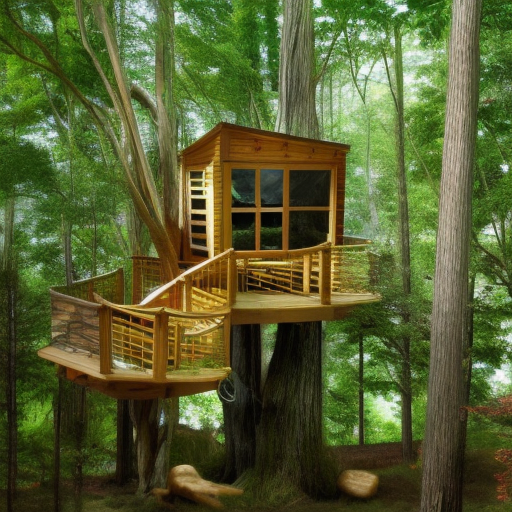
and a prompt of "realistic mermaid home" provided:
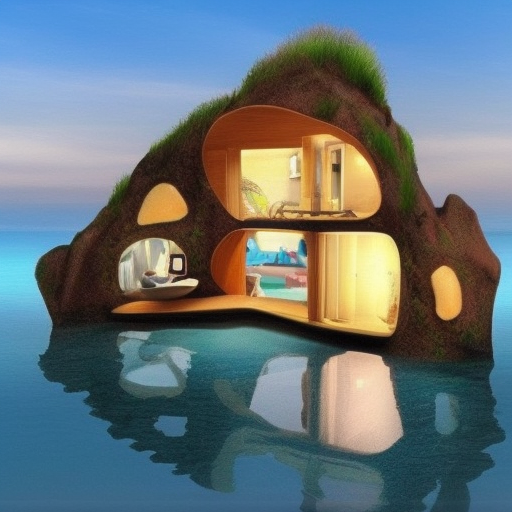
I would like to find pipelines whereby I can quickly reproduce the output designs in Unity, in order to investigate them in my Quest 2.
I imagine artificial intelligence (note that I am not a big fan of the term) techniques assisting with the generation of 3-D models and texturing coordinates, using the ideation images as references.
Such investigation should bring significant motivation to this exploration, now that two feasible development pipelines
are working on my iMac and Oculus Quest 2. Using a Python notebook to manage development piecemeal should help my mind focus on relevant packages and algorithms for a productive step-wise process.
I created a Python notebook to use an Objectron approach to extracting architectural structures, with orientation, from the ideation images.
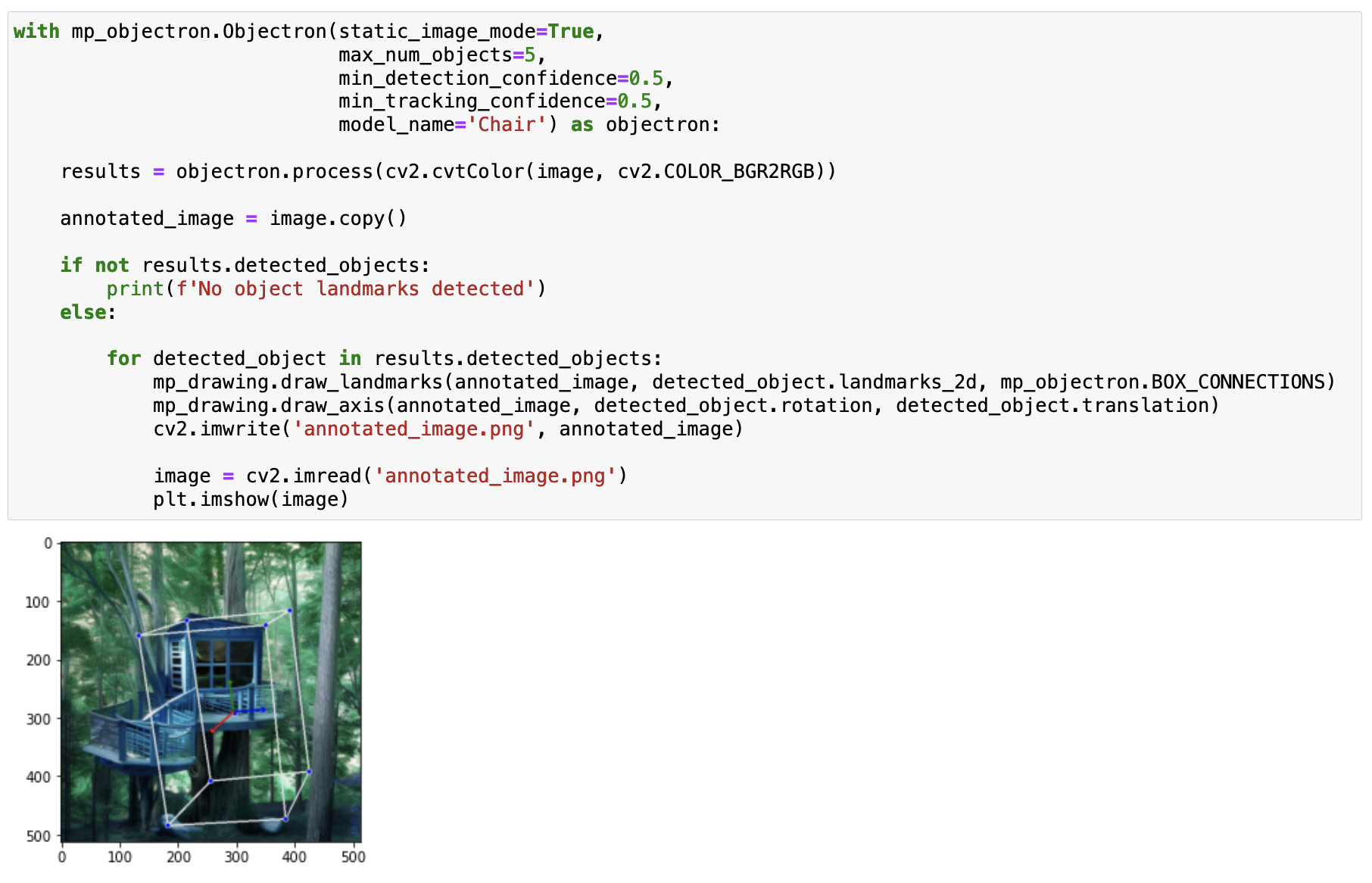
and then found an open source project that provides more insight into the Objectron approach:
https://github.com/zju3dv/OnePose
I will investigate that code with the intent of becoming familiar with the approach so as to apply to images containing architecture.
Meanwhile I will work on creating a pipeline through Blender that lets me handcraft the outputs of the AI tools. I like the idea of
coupled human-AI design so should remain motivated in that activity.
September 2, 2022. Another academic year begins 30 years to the day upon which I taught my first course
Although I enjoyed teaching four classes in-person on a college campus again during the RISD summer session, I'm enthused to return to an online format for the autumn courses. We have a full house for the immersion course I teach for the first time in a while and teaching in-person and online (with a thought only one of the two would meet enrollment) during summer was demanding to whereby I kept a tighter schedule than I had hoped to keep.
The summer courses went very well, except for one glaring exception. One of the online courses, that ran wonderfully in parallel in a campus classroom, lacked any talented performance that would likely have raised the bar for everyone. I rely on someone submitting quality work that suggests the work can be done by someone besides an instructor who has a 30-year career under his belt. That person did not come from the roster and so I was left with the conclusion that the best students were keen to come to class on our campus. They outperformed the online crew quite significantly.
I can now answer the questions I posed for investigation in my last blog post, written before the summer session began:
Q: How will they thrive in person?
A: In all four classes, the students seemed to thrive as they worked independently on their individual workstations while also participating well in the directed discussion.
Q: Will they have continued to become even more distracted by way of popular culture than they were when last in a physical classroom with me?
A: Not a single student, in four classes, seemed addicted to their cell phone. The students authentically enjoyed being with each other and yet only twice did students hold a conversation during a presentation I was giving. I was relieved to see less distraction than what I remembered from teaching on campus in 2019.
Q: Will they have the requisite attention span to synchronize with an instructor and a cadre of fellow students?
A: The students struggled to stay attentive to presentations regarding the coding components of the class. They were mostly there for the art way more than the code (there were only three exceptions out of 34 students). I'm OK with leaning that way as there are many other venues where students can focus on code and I suspect students I taught in the past might have chosen those options if they had existed. The art work was tremendous and they enjoyed integrating their art into existing code to see a interactive result.
March 10, 2022. Back to an on-campus classroom:
After over two years of delivering asynchronous classes through RISD's Canvas Learning Management System (LMS), and advising students remotely, I have begun to prepare for a summer on the RISD campus delivering four courses, across two six-week sessions, in person. I have begun to prepare for coordinating a summer internship on the Brown campus, with a computer science undergraduate student doing work at Michigan State University.
Time spent in a home office has been wonderfully rewarding, with the asynchronous lifestyle suiting me for its affordances in aligning with the biorhythms of day-to-day living. I have been paid better while potentially reducing costs for those who pay me. I have renewed a beloved collaboration with collaborators at the University of Washington, and gained a sense of being appreciated for being able to work so effectively off a campus that is over 4000 kilometers away.
I am very excited to work with an undergraduate with whom I have held Zoom conference calls and shared tens of meaningful e-mail missives, but I am unsure of going back into the classroom with a slate of students who have taken the first half of their classes by way of online mediation. How will they thrive in person? Will they have the requisite attention span to synchronize with an instructor and a cadre of fellow students? Will they have continued to become even more distracted by way of popular culture than they were when last in a physical classroom with me?
Time will tell, of course, and I imagine it will be good to see fellow faculty again, even if they continue a trend of not walking on the campus outside of necessary demands of returning to the automobile or getting to a bus stop. That trend, along with the one of students keeping their gaze on their phones, began when I first arrived in Providence upon finishing the dissertation defense. I imagine preferring a home office where I don't have to see evidence of that depressing change to social behavior — one where students know not what they are missing as they did not have my wonderful undergraduate experience of serendipitous discussions with faculty and students anywhere on campus.
June 13, 2020. URI and RISD teaching goes digital:
March 2020 the pandemic hit and threw curveballs at the academic experience experienced on college campuses. I had kicked off team-teaching another rendition of the PODS second course at URI and my data visualization course at RISD, and was settling in nicely with the joy of realizing all the students were enthused and appropriate for the subject matters.
It had taken me a while to load up the lab computers with the various software tools we would use in the data vis course. When I was told the course would be suspended indefinitely, I felt relief as I sensed how difficult it would be to reproduce the software environment on each student's work machines. Some students had already expressed frustration that their laptops were not keeping up with the lab computers.
During the RISD hiatus of four weeks, our URI course charged ahead and I saw how disruptive the change to online courses was for undergraduate students. We muddled through trying our best to motivate students who had other priorities brought on by day-to-day living. I was relieved when I was given the green light to run my two bread-and-butter online courses to complete the RISD Spring semester (they are half-session courses that have had all the kinks worked out over 10+ previous sessions each).
But as I venture forth into a "new normal" for our RISD program (we won't be back on campus until September 2021 at least, and perhaps never if we are as successful at remote teaching as I suspect we can be — my fellow faculty members are amazing artists with great grit and determination and just need a little time to get over the angst of an online delivery), I slave over a three-week process to create the 100+ videos I sense I need to teach six courses over summer via remote instruction.
We will invite an international community of students to take our courses, from where they work, play, and otherwise live. I have appreciated students coming to my online courses from afar as they have brought wonderful expansion to what is typically a Boston-area/Rhode Island myopic perspective (albeit a very successful one competing with the rest of the world so far).
It's time for me to walk the talk of all those demonstrations of useful, augmenting computer-assisted communications ideas over the thirty years since I first dabbled in Lotus Notes and began to develop facilitating, enabling, experiences for human collaboration and shared activities. I wonder if we can match the metrics of such an experience to our sense of accomplishment and merit? It will make sense to teach in isolation for each student as they arrive with different cultures and primary languages, but I see a day when we can maintian and celebrate diversity while taking advantage of better knowing each other through craft and critique.
July 10, 2019. The end of a meaningful grant period:
Upon finishing the fourth course and fifth course of our PODS sequence, my work with creating the PODS program at URI officially ended. The next step is to create an online version of the course sequence that can be shared with other institutions and our aim is broad in that regard.
We have a new domain, podsonline.us in which to create the distance learning sequence. Of most interest to me is the work needed to create meaningful virtual experiences of the ocean, bay, and river where for the URI classes we went out into the field to experience data collection first hand.
I have no doubt that everyone on the planet could benefit from knowing the ocean better through data, and in developing a data science skill set to rival their skills in reading, writing, and arithmetic. No doubt I am ahead of the curve on this idea but I could see this work carrying me through to the end of a fulfilling career. Just need a little help (and encouragement) from my friends. Finding new streams of funding won't hurt either!
November 11, 2018. Adding life to ocean modeling:
The third course we've been developing for the Proficiency of Ocean Data Science program at the University of Rhode Island (URI) has felt a blessing to my personal growth. After enjoying my first 3.5 years at Brown modeling behavior at tectonic plate boundaries and large ocean current effects on coastal waters, I've happened upon the experience of considering life in the water.
Many scientists in my environs the last twenty years have developed a love from the appreciation for plankton, but I never have had the opportunity to work closely with them. As usual, I picked up a fair amount from being in the room with them on occasion (overlap in knowlege bases seems necessary), but I didn't actually put my head very far into their space.
This course I've participated in developing has provided me classroom time, book and literature time, and computational modeling time in order to think deeply about how physical things become organic living organisms. Autotrophs, chemotrophs, and molecule fixers do the work we humans are incapable of doing. And yet we gladly participate in the food web they initiate as primary producers.
And to think I was making inanimate things come to life in my mind in order to engage more intently with work visualizing their contribution to our physical planet. To become more attentive to the plants out there that physically make inanimate things come alive has suggested a more natural source of intent — less mental forcing and more passive absorpsion. The course has tied so many concepts together — a metaphor for what we humans do on a daily basis.
Such a sophisticated world of causes and conditions and yet we sense the process of a super-organism regulating it all to make change adaptable for most. Not hard to see what is at risk in terms of encountering a tipping point away from a synergistic and self-regulating stasis and yet we trust the familiar will maintain. Why we would roll dice through ignorance is hard to come to grips with. The only answer I come up with is that we are not above evolution... evolution that pushes every species to see where it can progress to when pushing as hard and fast as it can. Taking my head out of the ocean, I can see a few trajectories forward for our evolution. Certainly can see where time and money is being invested. Change can accelerate and resonance between changes can accumulate.
A strong sense of stewardship is hard to pass on as immaterial.
April 12, 2017. A meaningful talk at URI:
On April 12th, 2017, I gave a Mark Stoermer Memorial Lecture as part of the Marine Geology and Geophysics (MG&G) Seminar series at the University of Rhode Island (URI). A standing room only crowd provided a welcoming, collegial feel as I presented an overview of the contributions Mark provided me and many others through twenty-two years as steward and Director of the Center for Environmental Visualization at the University of Washington.
I had not felt so emotionally connected to a talk since I had a Pucha Kucha experience in 2011. There is something about a packed house and a palpable energy level that make talking about a passionate subject pass over the threshhold to visceral. I am not sure I could survive a life of hitting that emotional level on a regular basis and yet I do hope my students over the years suggest I did an adequate job of using emotion for motivational purposes at the most appropriate of times.
I don't think I could feel more present than after giving a passionate talk whereby the sense of time and place erodes into becoming irrelevant. The experience of coming back from that state is quite dramatic and yet quickly forgotten by its disconnect with day-to-day life. Perhaps it's the connection to a placeless and timeless spirit that blankets the universe to give the appearance of meaning while faithfully cranking out the algorithm of evolution of which it is evidently devoted.
I liken it to another experience I know I have but cannot relate very well verbally: When I attend the symphony and the music begins, my mind drifts to some most desirous place. There, I recognize it and praise it for the perspective it gives me that lurks on the edge of pleasure. I've come to the point whereby I sense it is the act of making many cognitive components of my brain resonant (those parts that suppress verbal chatter) that I experience what I can only suggest is joy (I should know a better word).
The strangest thing is that when the music ends, I drift back into my usual cognitive patterns and the experience fades. I have done well to remember that something magical happens, but I have not been able to remember what it is. I must return to the circumstance of the symphony to recognize it again (or, perhaps, I would benefit from more instrumental music of which I am unaccustomed to hearing). It might haunt me, perhaps, but it doesn't leave me grasping for more on a visceral level. It's as if I intellectualize the whole concept and that just doesn't get me going back all that often. Ditto for the opportunity to give talks on extremely passionate subjects.
February 9, 2017. About this darn data falling in my lap:
Wednesday night was a relief. I arrived at the third week of the second course of the Proficiency in Ocean Data Science program with a pounding migraine headache that demanded I find some coffee on the University of Rhode Island campus. Then I proceeded to participate in class with an emerging awareness that we are arriving at a vision for which we wrote a three-year grant proposal a year ago. I thought I would gain access to some coveted regional ocean data and work with those scientists who consider it the backbone of their careers. I thought I'd shift my perspective, if ever so slightly, towards a better consideration of its bounty. Our first class gave me time to explore and become familiar with all the devices and environments where such devices are deployed. We are sensing our environment is so many ways these days.
Playing around with software that has been created to integrate analysis with scientist workflow, I realized how much easier things were on that front compared to when I first started such an endeavor in 1996. I had learned some requisite programming languages that make the tools work for me (the goal of our program is to embed that knowledge in young scholars in new and meaningful ways), and I had figured out how to search the Web, and network with people, in order to sketch out an analysis of interest and pursue it to the best of my ability.
I have come to the awareness that life as an ocean scientist is changing for many. My five days on a research vessel, floating on the high sea, working as a community pursuing data acquisition and initial verification through well thought out communal tasks, were not the mainstay of ocean science data progress anymore. Still one of the important parts of the endeavor, the ship at sea has become less important for many data acquisition processes performed by satellite, floating buoy, or tethered mooring station. And yet, the high seas remains an active domain for the trafficking of so many things that are in demand from citizens of planet Earth who are becoming aware of an emergent global culture through global processes.
Those many seamen and women who are out at sea facilitating the collection and delivery of our wants, and perhaps needs, are not necessarily being fed by top-rate chefs and accessing top-rate computing facilities for entertainment and engaged thought. They are fighting for appreciation from those who have such luxuries and yet fear for their jobs in this drone, driverless, software-driven world we seem to be racing towards. There are organizations out there like the Marine Injury Center and people who pursue legislation like the Jones Act on behalf of those who might easily be forgotten as backdrop to our material lifestyles. There is a lot going on right now with ocean science and the need to understand our climate better. But we continue to try to build awareness for all things ocean as everything feels so interconnected and dependent on it.
November 1, 2015. A month into a visiting scientist designation at Brown University:
Yesterday was a great day. I walked across the Brown campus and along Thayer Street out to my car that's occasionally parked on the outskirts of the manmade density in the area (I wish I could say I took the bus, walked, or cycled every single day like in Seattle, but I'm in a mode where a meeting with colleagues twenty miles away might spring up at any moment). For the first time, I felt at peace as I did during long walks across campuses where I was enrolled officially as a student or worked full-time as research staff (or in the case of the Travelers Insurance Company, collaborated in corporate America among multiple buildings). I have always liked feeling part of a sangha while at the same time been hesitant to label myself. The scientist label feels heavy from the respect I have for it. It's hard to survive as a scientist in today's world. And yet, I think I have figured out a way to at least belong in the chase. Everyone should shadow a hard-working scientist on occasion just as everyone should shadow a hard-working artist. They see the world differently as a result of well-defined education, experience, training, and social networking norms. They bring memetic diversity to our ecosystem of human thought. And, they produce fascinating artifacts that would not get produced otherwise.
Is it time to morph scientific thinking into our daily existence? And, if so, how do we do it effectively for the benefit of each one of us? I'm dusting off the notes from a mad dash to understanding distributed cognition during 2005-2010 and interpolating it forward to get ready for another mad dash (the adjunct research professor label only lasts until June 30, 2019 unless I do something to extend it). I'm looking at this complex human activity we call the environmental visualization pipeline and figuring out where the cognition of the scientist best distributes across the activity to improve the end results. I might still cling to insight and understanding as metrics of choice since decision support continues to feel a bit risky (and seems to be sabotaged by political will all too often). The opportunity to educate K-12 students in ways they better appreciate the scientist and can envision that role might just come out of this work (especially if the funding organizations decide to invest in it). And, of course, what's always great is that distributed cognition is something we all participate in — to understand distributed cognition is to understand the process of understanding better. Self-help is on the way.
February 14, 2015. Appreciate this point-of-view from Magic Ink:
Industrial design brings art to existing mass-produced technology, but printing brings mass-producing technology to an existing art [and the two spill over to the virtual realm]. In the virtual, these parallel evolutions have produced designers for interactive machines (conventional software) and designers for static page layouts (conventional websites). From this viewpoint, the chimeric effects of convergence are almost to be expected. The emerging "interactive web" embraces a ludicrously mixed metaphor of machines on pages, a monstrous hybrid of virtual mechanical affordances printed on virtual paper. Information is trapped behind interactive mechanisms and presented in static layouts — the worst of both worlds.
He eloquently states my reason for moving my teaching audience from engineers to artists: There may be multitudes of artists, currently drawing business graphics or maps or comics, who could excel at information software design if they had any idea that it was a legitimate artistic field. Recent years have brought a wealth of beautiful amateur websites, created by visually-oriented people dabbling in the only sort of software design accessible to them. But because full-fledged software is seen as an artifact of arcane technology, a product of “programmers,” these people lack the confidence to consider life beyond HTML.
And then there is this: Since software design isn’t yet recognized as an artistic field in the first place, its situation is even worse — the very concept of a gallery of software designs will seem absurd to most people. But a corpus is crucial for the development of any artistic field. Outstanding designs must be recognized, collected, and explicated. Furthermore, outstanding designers should be recognized and encouraged to teach, instead of hidden behind a corporate label.
February 12, 2015. Thoughts in discussion with a collaborator:
I hear you when you suggest 'data artist' is way too easily misunderstood as a simplicity. My latest term for what I do is 'technology integrator' but it is really frustrating to try and put what I do into two words (and in my case you have to include data visualization as a technology and to do that requires the broader definition of the term). I really work in pipelines with a feedback loop (thanks to computing interfaces allowing that of late). The integration comes in getting an envisioned pipeline technologically feasible (and optimized for real-time use in many cases).
Thanks for the dialogue. I think these dialogues are where common ground is negotiated... and it should be negotiated as a moving target. I'm struggling with your point of view. RISD is an 'art and design college'. If you go into the architecture or industrial design departments (where the big money is made by the school and its graduates), they would suggest their biggest challenge is to inject art into design because design has been going on without art for too long (and RISD designers get huge rewards for injecting art into design environments where art has not been considered relevant). When a scientist designs an experiment, art is often the last thing on her mind.
I think the focus on making progress via art-science collaborations has to focus on a willingness to look at professional training, knowledge bases, skills, practices, and networks and deconstruct them to suggest the two camps have a wonderful opportunity to redesign those based on current and near-future objects, artifacts, and social processes that didn't existed when the norms entrenched. Tools that are intuitive for artists are gaining interfaces that make them accessible to scientists. Tools that are intuitive for scientists are gaining interfaces that are intuitive for artists (and yet perform the tasks the scientist has been delegated previously).
To me, design seems to cut across both art and science... during all those years of designing interactive form-based interfaces to computational software, I was considered a designer, but I never once considered myself an artist. That was a mistake... I should have thought of myself as an artist in terms of a point-of-view that would have been valuable to bring to the activity at hand. Training, knowledge bases, practices, and human networks should have included the artist's perspective as it was so relevant to design.
So, to me, the idea of an art-science collaboration cuts to the core... the artist searching out what is meaningful to understand in this life (exploring context) and the scientist bringing tools to shed light towards understanding following the scientific method. That's where your case study sheds light... the art students looked at the core of what the scientists were pursuing and extracted the relevant meaning to us all. The fact the design process was done by the artists more than the scientists is what made it more intuitively understandable to those who experienced the exhibits.
I see this as a case study of design through art-science collaboration. What would the design process have yielded with only the artists working on their own with the papers and data of the scientists? What would the design process have yielded with the scientists trying to create exhibits without the artists? Did the feedback loop and synchronous discussion have a meaningful impact on the result? Was the result better than what either camp would have designed on their own?
January 23, 2015: Hello 2015:
I find myself coming up on twenty years of adding to this page where I've tracked all the wonderful organizations, communities, and bodies of knowledge I had access to during a coming-of-age epoch of my life. My 30s and 40s were consumed with seeking out interesting groups of people doing interesting things and I had the unbelievable luxury of attending conferences, meetings, symposiums, and short-courses on behalf of a collaboratory with an explicit mission to investigate the proper use of emerging technologies to unlock and augment human cognition for the benefit of mankind. I bought the hypothesis that distributed cognition was of great value to many activities that require joint cooperation to have any chance of success. My thesis suggested metrics that when applied corroborated the hypothesis.
I had been warned that I started late and that I'd become invisible as I progressed into my 50s. It was with a sense of urgency that I balanced my focus on technology (and its virtual, intangible spaces) with a focus on the natural world whose awareness seemed to be suffering though the transition to an information age of abstract representations of things as information (which followed an industrial age that provided a slew of harsh transitions from previous natural states).
No doubt one's wealth can be severely affected by conscience and the pursuit of enlightenment, but I couldn't trade a life of continued ignorance for what has been attained by indulging the contrarian voice within. My day-to-day joy seemed at risk to end if I continued as I had in youthful decades. My coming-of-age license has expired. Fair enough. I'm just fine with my life expiring someday and so it seems the transition to that day might as well begin now. Seems grace through loss is going to require some commitment. Thankfully I have already learned it will be through the best case studies of cultures and biographies that I will find my best path — just as it was through case studies and biographies (many being written by kind and generous mentors) that I found my way to come of age.
|
4/11/2007 - Virtual Cities OK, so creating video games is quite a popular pursuit. There are degrees for future designers, programmers, testers, reviewers, etc. Great promise for changing the way we learn. But, how do we push out a project to a community effort? Web 2.0 says the people have the power when it comes to content. I'm thinking the ultimate community project, just begging to be attempted, is the virtual city. Google Earth provides the globe for us to drop our city onto. Google provides a nice SketchUp application for beginners to quickly produce virtual buildings and other architectural structures. Could we get a whole town to quickly model all structures and have someone stitch it into a coherent whole? Certainly, the time has come, no? Twelve years have passed since the Virtual Reality Modeling Language suggested a road for us to follow in building virtual content. Planet 9 Studios has professionally built virtua] cities (San Francisco and New York kicking them off). I think someone ought to attempt to get a city to model itself from the ground up, grass roots and all. Hopefully, my Virtual Cities page will promote the idea well enough to find interest out there. If we build it, they will come (right?). see: planet 9 studios: home page |
|
|
5/15/2005 - A Degree in Video Game Development So what should a degree in video game development look like? Well, personally, I'd like it to look more like a simulation theory degree with more science and mathematics involved. Most of the associate degrees out there promote computer science skills that are more about understanding how computer languages and popular software interfaces work. As the RPI Web site mentions, 'Other institutions offering classes in video game studies include Princeton, Carnegie Mellon University, Massachusetts Institute of Technology, and the University of California at Irvine. There are also specialized schools, like DigiPen in Redmond, Washington, that teach nothing but game design'. Seems to me courses on inputs (informatics and information theory), process (e.g. artificial intelligence, data assimilation, kinematics), and outputs (e.g. artistic rendering, data presentation, architecture) could expand to include a wealth of topics that have overlap with the general background education a liberal arts student would want to gain during undergraduate study. Seems using the computer as the center of course deliverables focus would be pretty interesting. We've been using paper as the focus for long enough. Just think more expansive on this theme of computer as learning delivery vehicle and then consider the potential of simulating those phenomena you learn in math and science (alongside the skills gained by requiring the deliverables be explained in clear wording) in order to prove to others you understand them. The degree then becomes more about creating an interactive cyberspace (hopefully with modular pieces) than creating a single video game using the popular methods of today. see: RPI: Games and experiential media 5/10/2005 - Nine Years Later Of course, yesterday I should have mentioned the heroic efforts of certain forebearers. The code bases whipped together to connect people worldwide in 3-D cyberspace were a blast to participate with. If only that same heroic effort could be applied to today's open source design patterns in our realm.
see: digitalspace traveler: home page 5/9/2005 - Open Source Integration After paying $19 a year to participate in a cyberspace building community experiment that took off in a nice critical-mass curve, I decided I'd wait for an open source graphics-engine to be incorporated into a platform I could help extend in a similar manner. Seems there is a common pattern out there for properly integrating other open source components into a scene-graph based graphics engine. If only we could move ahead and get academic departments all over the world working on the same grand vision. We'd not only have a platform for connecting in cyberspace, we'd have a place to try out interesting algorithms, play interesting games, interact with interesting data, and do some important research as to how these cyberspace platforms could be used more effectively. Seems Rensselaer Polytechnic is building a video games major (I read it in the alumni magazine). Certainly part of such a degree should be spent developing the underlying environment on which games can be rolled out en masse. Who else is going to follow suit? How long is it going to take to get this going (and having the different students from different universities participate in one massive project? see: activeworlds: home page 5/8/2005 - Whole Earth Interfaces After paying $79 for a whole earth interface application four years ago and forking over $49 a year later and $39 the year after that, I finally downloaded Google Earth for free and kicked my paying habit. Such a nice raging debate over whether the world will pay more attention to critical whole Earth system data sets now that they can map data visually to an interactive earth accessible over the Web. The pale blue dot syndrome, as Carl Sagan calls it, comes to your home PC. Just look how vulnerable our sweet little planet looks floating out there all by its lonesome. Of course, the world disappears under the ocean on 2/3 of the surface. That's silly, eh? Ocean data sets will turn out to be the real important ones as they become more and more available. El Nino. La Nina. Driving forces that make winners and losers of communities on land. Thankfully, we have two competing products already. One starting with scientific data and the other with more recognizable data (aerial photography of city flyovers). How excellent they've covered all of Indiana! Now, if only you could launch other applications from these planetary starting points. Hmmmmmm. Now there's a lot of potential in *that*, for sure. see: google earth: home page 5/6/2005 - Grid-enablement Software Three days in San Diego attending a Globus 4 Toolkit Tutorial and Workshop got me thinking more about the potential of grid commuting emerging on the scene sooner rather than later. Sure, I've run a few multi-participant sessions on the Access Grid to attend conferences or connect with lab collaborators, but I hadn't thought much about how a certificate-based access point might be my key to the all the worlds computers some day. We've been developing some SOAP-based Web services to connect disparate systems by binding to various programming languages. We've been using WSDL and WSDD to identify and deploy them. But, I hadn't thought through how every programming task on every computer in the world could be accessed through a unified front based on those specifications. Nor did I expect the Globus 4 Toolkit to be based on such underlying components. No doubt sitting at command central of such a grid-enabled empire could be quite a rush. What a potential for visualization... virtual communities, virtual organizations, virtual identities, load balancing statistics, and job control procedures lighting up one step then the next. No wonder why so much of the workshop revolved around security methods for protecting one's assets while connecting them for others to use. See: access grid: home page 4/28/2005 - A 3-D Operating System One of the most intriguing first few lines of a Web site I'd seen in a while starts off, "If we were to create a new operating system and user interface knowing what we know today, how far could we go? What if we had the robustness of a 3-D immersive technology, the diversity of the Internet, and the degree of social interaction we have in the real world?" Seems to me the XBox could fill that niche, but probably only if there were demonstrated return on investment during an incremental approach that got there eventually. That trajectory seems to already be on its way, but led by a product team that is bound by a particular corporate culture that demands XX% return on investment. What if we could come together and create a new operating system from the ground up in a way that let us play with unique ideas irrespective of a demonstratable market? The open source vehicle suggests the possibility. Could we actually create a market along the way while teaching a new generation of gamers and learners how to use that paradigm to redefine the computer away from the personal business productivity box that gave us its first investors and implementations? Seems we could use a new way of engaging our imaginations. Is a project like the Croquet Project the way to go about it? A third entry link: croquet project: http://www.opencroquet.org/ 4/26/2005 - Visualization Toolkit After attending PyCon 2005, the Python Convention, I became convinced that the Python community was worthy of supporting, just as I had given my heart and soul to the VRML and Java 3D communities in years past. I realized that the VRML community was a little too .com bulge for me (one too many extravagant parties instead of putting energy into making VRML successful on the Web). I felt like I was part of a great Java 3D community, but I then realized it was because I had access to the first alpha release and was only one of fifteen or so people really kicking the tires on a mission-critical project. The community was small and very easy to work with. But, alas, the project manager at Sun wasn't too interested in the community or the casual home user. Java 3D was all about middleware for high-performance computers that would crunch polygon integration for visualization of millions of polygon data sets worth megabucks to Sun in potential revenues. Fair enough, but a lost opportunity. I see there is finally an organized community around Java 3D but I don't get that passionate feeling of making a difference on the Web through the use of it. Enter the Visualization Toolkit. Python-wrapped and ready to be driven by all the well used Web protocols. Time to dive in and see what that means regarding Web integration potential. Some second entry links: vtk site: vtk 4/25/2005 - So this is blogging? After setting up blogware twice before, I finally decided to bite the bullet, get myself my own domain, and set up the blog link off the home page front and center. I'll be blogging about things that are related to my dissertation such as the process and utility of generating scientific visualizations for consumption on the Web. Supposedly, up to seventy-some percent of brain activity is focused on processing the photons of light that enter our eyes. Seems there is an opportunity to make that a better experience than staring at a blank wall or reading the same forty or so keyboard characters over and over and over. Not that reading isn't the coolest opportunity afforded our brains since we get to invent our own imagery to connect to the words we read, but there is an opportunity to investigate certain phenomena more literally through our visual cortex and hopefully inspire us with experiences we aren't apt to run into in our daily existence. Photography is wonderful and I am sure some blog entries will be about a cool photo I've come across on the Web. But, I am more interested in seeing stuff that is abstract and yet inspired by nature. Supposedly, we need tools to help us experience those beauties. Visualization toolkits, for example. I hope to tie together some thoughts I've been having in a way that others might just want to follow along. Hence the blog. Some first entry links: a site: Earth Science Picture of the Day (more to come) |
|

On October 14-17, 2024 I will attend VIS 2024, after an eight year hiatus. I am hopeful that the conference has some new tricks to share with this old dog, but the best part will be seeing the community in person. E-mail me if you want to connect outside of the conference, or if you want to confirm a specific meet-up place and time during the conference.
 On October 26-30, 2020 I attended VisWeek 2020 online in the conference corner of my home (a corner of the living room never used for any other purpose). I found myself enthusiastic to experience a conference that had often inspired me in person, but via a remote interface that looks great on a big screen monitor. I expected the process to be as insightful as PyCon 2005, when I experienced my first bottom-up, wiki-coordinated, conference as coordinator of a Visualization with Python paper presentation session. I expected it to run at least as smoothly as the other four virtual conferences I had attended during the pandemic had run.
On October 26-30, 2020 I attended VisWeek 2020 online in the conference corner of my home (a corner of the living room never used for any other purpose). I found myself enthusiastic to experience a conference that had often inspired me in person, but via a remote interface that looks great on a big screen monitor. I expected the process to be as insightful as PyCon 2005, when I experienced my first bottom-up, wiki-coordinated, conference as coordinator of a Visualization with Python paper presentation session. I expected it to run at least as smoothly as the other four virtual conferences I had attended during the pandemic had run.
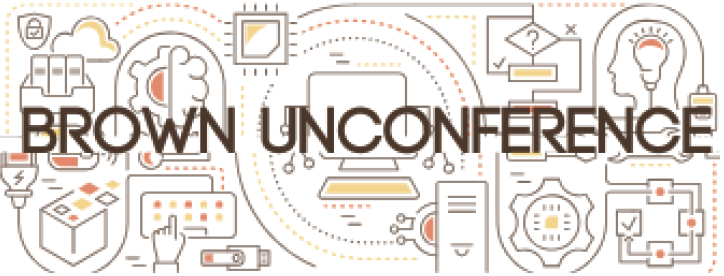
On June 29-30, 2020 I shared a presentation entitled Proficiency in Ocean Data Science, CMIP Earth System Models, and Machine Learning Potential at the Brown University Unconference. The presentation detailed our approach and results attained from developing the PODS program, how it has helped consider approaches to CMIP data set visualization, and how the next steps would include incorporating machine learning algorithms into the analysis notebooks used in PODS. The conference coincided with my last two days working on the ONR grant that supported PODS program development.

As the next step for PODS was to create a distanced learning version of the courses, I attended Petascale Computing Institute 2019. As a result I feel both motivated and capable of creating a virtual river-bay-sound model that students will be able to interact with using virtual technologies and the web.

On April 4-8, 2019 I attended AnacondaCON in Austin, TX, to present a paper entitled Proficiency in Ocean Data Science (PODS) education through innovative learning experiences and technological support. The presentation detailed our approach and results attained from developing the PODS program.

From April 15, 2016 to June 30, 2020 I worked on a grant from the Office of Naval Research through which three research PhDs and myself created a Proficiency in Ocean Data Science (PODS) series of five courses intended for undergraduate students. We piloted four of the courses at the University of Rhode Island and a fifth at the Rhode Island School of Design. As a result of being consumed with the creation of a new academic program, I had a three-year hiatus in any conference activity.

During October 21-26, 2016, I attended the VIS week festivities in Baltimore, MD. I started with the CG&A editorial board meeting on the weekend and then spent time catching up with colleagues in the Visualization and Visual Analytics communities. I noted a fair amount of stress among the attendees as funding has been tight and the demonstration of new insights for research has been a bit stagnant. But, there are some tremendous practitioners who come together to hopefully inspire new directions. I had a useful time as an invited guest of the first Discovery Jam during Visweek.
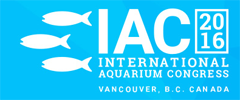
During September 16-20, 2016, I performed the duties of a delegate at the International Aquarium Congress in Vancouver, Canada. And so ended my eight year run of working as a data visualization and ocean awareness consultant for the world's large public aquariums. I don't think any other responsibility will feel quite as global, as exotic, or as satisfying as what culminated in the congresses in Shanghai, Cape Town, and Vancouver. We came together as a congress to look at energy sources, fish health, and climate change communications and find meaningful solutions for the world's aquariums to implement from a best-of process run like a mini United Nations of sorts. If only everyone got to participate in such an international group so intimately (a memoir of sorts).

On September 7th, 2016, I kicked off the Proficiency in Ocean Data Science program at the University of Rhode Island. Along with three ocean data science research faculty, we started a unique classroom experience for undergraduate students who are interested in a career in ocean data science. Funded by the Office of Naval Research for three years, the program should get off to a strong start which we hope to maintain through great collaborations and sharing with developing programs throughout the country. Our goal is to set off careers as ocean data scientists for many motivated young people who are keen to stay in Rhode Island for Navy work.

In Los Angeles, during August 9-13 2015, I attended SIGGRAPH for the first time in nine years. I attended because the CG&A editorial board met in the vicinity the weekend before and I looked forward to seeing the advancements in VR being presented at the conference. During the board meeting, I stayed in a corporate hotel with 3x the space necessary for my comfort. To shake that isolation of excess, I used airbnb to find a collaborative artist loft in the Toy District and ate gourmet meals (scallop supper, chicken parmigiana, primo Waldorf salad) with interesting artists doing active work for four days. Fantastic. Sure I felt old at SIGGRAPH but a great side-effect of being in VR for hours at a time is you lose track of yourself in there. The demonstrations were adequate and the storylines were more hopeful than the day-to-day media read tracking VR. I particularly enjoyed an immersive film providing me a tour of the Mandelbulb3D fractal environment. And, I enjoyed the program at the University of Southern California that provided me an afternoon and evening on campus (I had never been on campus before).
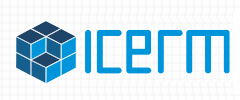
During September 15-19, 2014, I attended the Information-Based Complexity and Stochastic Computation workshop at Brown University. Ramping up my editorial abilities for a regular Art on Graphics column in Computer Graphics and Applications magazine means more time catching up with scientists in the complexity and stochastic computation field. Hoping to inspire information visualization processes I have been working on lately.
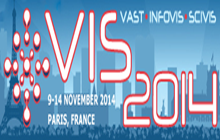
As of August 1, 2014, I am done with my direct academic responsibilities for VIS 2014 unless I find some funded opportunities to do more work. Guess I wouldn't mind getting over to Paris for the conference this year. The IEEE VIS 2014 Arts Program should be put through its paces well in Europe for the first time. The quality of papers was particularly high this review compared to last. Please help Francesca Samsel thrive at the conference as she'll be my eyes and ears along with others.

On July 15, 2014, Francesca Samsel and I kicked-off a new Art on Graphics department within the IEEE Computer Graphics & Applications magazine. We will be editing submissions from artists who have done significant work with computer scientists or other scientists to improve a visual process, whether static or interactive via an application. Assuming that process goes well, we'll be looking to find other approaches for improving innovation through artistic training and expertise.
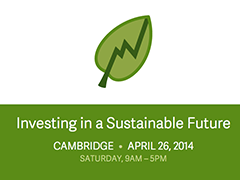
On April 26, 2014, I attended the fabulous Investing in a Sustainable Future program at MIT — a daylong get together of economists and environmental scientists to discuss where their bodies of knowledge should overlap: advising conservation for a functional planet through sustainable processes (investment markets being one of the bigger ones). Fantastic case studies on Chinese apple orchard pollination and Sudd Marsh in South Sudan made the day highly memorable.
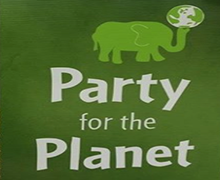
During Roger Williams Park and Zoo's annual Party for the Planet during April 21-25 2014, I spent time with Providence and Boston area families discussing their actions and the state of the ocean. Nothing feels more immediately impactful than talking to your greater neighborhood on global affairs and their place in them. I had three wonderful interns with me this year so we broke new records for effectiveness.

During February 18-21, 2014, I joined a review panel to advise the iUtah program on possible improvements to their second-year initiative. Working with four other colleagues who came into the state for the review with different academic backgrounds, we listened to two days of presentations and a day of critique before beginning to write our report. Thankfully, I was invited back two years later to perform a progress review. The team had delivered on much that they had suggested they would and details of the science approach continue to be highly useful.
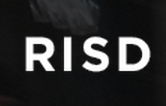
During Oct-December 2013, I buried my head into creating a portfolio of some of the work I've done since 1996 — while staying local in Providence, RI. Not too many people want to read a book that hasn't already been recommended by Oprah or the New York Times — that's quite an investment of time. Hopefully, they'll play with an interactive portfolio where each example will be worth hundreds of thousands of words. The process is quite enjoyable as I get to revisit aging C, C++, and Java code and port it over to the exciting realm of HTML5, CSS, and JavaScript.
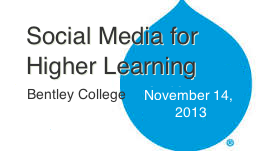
On November 14th, 2013 I attended a day-long conference looking at creative uses of social media at institutions of higher education. I represented RISD among those who mainly represented business schools. I enjoyed catching up on the latest Drupal developments that should be attractive to higher education. I finally stepped foot on the Bentley campus which I had never done before — surprising considering all the time I've lived in the Boston area.

On October 12th, 2013 I attended a day-long, well-organized economic and environmental justice conference with some of the best and brightest minds in Providence. I enjoyed socializing with everyone as we discussed the ramifications of a government shut-down and stratification of wealth issues. Everyone should attend such a thought-provoking event to challenge assumptions and compare realities to ideals. Case study presentations suggested a country can only be strong and viable in the long-run if it takes care of its economy and environment in a mindful manner. Celebrating a good friend's birthday while hosting a good friend from Detroit made the day especially memorable.

On October 6th, 2013 I visited the Brain and Cognitive Sciences center at MIT. I had been invited by the Eyewire folks who run a game designed to map neuron cells of a retina scanned in high detail with MRI technology. I support bottom up approaches for supporting science and the game is a compelling example reminiscent of ground-truthing activities in remote sensing research. Two of my clients are winding down after multiple year contracts so it's time to find an interesting project to coordinate or collaborate upon. No better place to start than with this fine group of researchers. A wonderful day in Boston with new possibilities on the horizon.

On September 20th, 2013 I visited the Joint Institute for Food Safety and Applied Nutrition labs at the University of Maryland. The institute had recently increased their staff of PhD researchers from two to six and had increased their world reach thanks to the momentum of changes to the Health Maintenance Act in DC. The labs were full of visitors from all over our lovely planet — learning testing methods and food safety requirements should their food products be exported to the USA. I was especially pleased to see water testing labs similar to those I worked near at the University of Washington. I was also enthused that the ten information technologists supporting the lab were interested in data visualization methods. Great day of discussions and perspective. I fondly remembered the days of being a researcher at an international lab.

During May-August 2013, I buried my head into writing a new book, The Simulaton Life, while staying local in Providence, RI — taking longer than expected thanks to the quality of students in five classes I taught at RISD. The resultant first draft will receive many iterations. I am hopeful the book might motivate others to understand my passion for simulation as understanding and hopefully find new collaborators willing to put serious effort into that endeavor.

On April 12th, 2013, I spent a day at the UMass-Dartmouth campus as a guest of an ex-student of mine who was to graduate with her graduate degree in Digital Media and Arts in May. We spent time in the Architecture, Fine Arts, and Visual Design/Digital Media departments. The campus teaches a virtual reality course that is reminiscent of the great courses in which I participated at the University of Washington in the 1990s. Always a great day to relive old thoughts with new context. The campus is a thriving campus for young faculty making a name for themselves — just 20 miles from Providence.
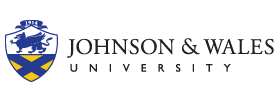
On March 22nd, 2013, I attended the annual RI Compost Conference on the Johnson and Wales University campus in Providence. The harbor campus is wonderfully vibrant on a Friday with a campus-wide focus on exercise after a week of enjoying the spoils of the world-renowned culinary arts program each week. Narragansett Bay was shimmering and the community discussion on compost seemed to hold the ideal "think globally but act locally" focus. Lots of hugs for an east coast venue as I found many kindred spirits attending with me. So many interesting ideas for getting compost awareness and programs even more active in our state — and yet a keynote speaker who had an actual recipe that had worked to perfection in Hamilton, Massachusetts.

On March 9th, 2013, I attended the RI Land and Water Summit at the University of Rhode Island. No better place to see everyone from the water conservation community I haven't seen in one place in a while. So many good workshops from which to choose. I became enlightened on stormwater district utility formation, coastal community relocation, and optimal residential street upkeep for multi-use promotion (horray for empowering pedestrians and cyclists) — all in the usual quirky Rhode Island way of approaching things.
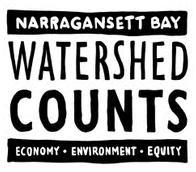
On January 8th, 2013, I attended the Watershed Counts 2013 kick-off with many of my colleagues from the Rhode Island and Massachusetts watershed organizations. I enjoyed spending time with my peers but have developed a deeper awareness of systematic flaws in the process we are supporting. As a result, my role as a trained systems engineer will be harder to incorporate into group process than I was hoping. The lack of systems training in our society has many feeling overwhelmed by complexity instead of chipping away at it methodologically. Follow up meetings on February 27th and March 13th solidified our consensus on metrics to pursue for 2013.

On November 19th and 20th, 2012, I re-visited the New York Foundation in New York City to review the first year of working with the new team — coordinating community organizing pedagogy through an on-line community funded by the Community Learning Partnership. We then mapped the year ahead which included merging our website technology with a group in San Francisco. My days as the sole webmaster are over. It was great to spend time with the collaborators I have been sharing such meaningful work and conversation with over the seven years I was in charge of technical direction.
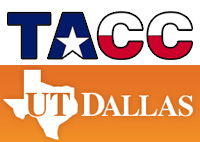
On November 7-12 2012, I visited two University of Texas campuses to investigate research directions. I was impressed by how quickly the Dallas campus is growing as my nephew took me for a tour of the campus that Roger Malina now calls home. Time in Austin at the Texas Advanced Computing Visualization center rattled some neurons that needed rattling. Thanks to Francesca Samsel for hosting me. Weekend at U Oklahoma with Chris Weaver was quite pleasant for career planning as well.

On October 14-19 2012, I attended the VisWeek series of conferences in Seattle, Washington. While representing RISD and performing conference organizing tasks (primarily as the art show chair with Dan Keefe and Lauren Thorson), I received a thorough update on all work being done internationally for better human insight and awareness in the realms of scientific visualization, data visualization, and visual analytics. The conference continues to grow as work picks up in wider realms and more organizations. Quite the community experience as usual.
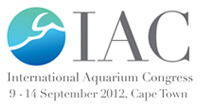
On September 9-14 2012, I attended the International Aquarium Congress in Cape Town, South Africa as a delegate. While representing the Watersheds Project and advising on visualization for aquarium data sets, I received a thorough update on all work done internationally for aquarium effectiveness and contribution to ocean awareness and animal conservation. The congress was excited to celebrate the work done in four years since the last congress — when we all committed to helping reduce energy use costs in new aquariums coming on-line in Asia and the Middle East. We committed to a new vision of no new wild captures for aquaria exhibits by 2016 (and no more release of sick animals back into the wild).
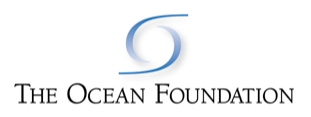
On July 30th 2012, I presented at The Ocean Foundation summer lecture series. Following up from last year when I introduced the idea of the Watersheds Project for community-based personal action for watershed quality initiatives, I provided an overview of how watershed modeling can be integrated with watershed council and waterkeeper alliance activities to build multiple competencies within the communities they serve.
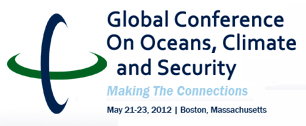
On May 22nd and 23rd 2012, I attended the Global Conference on Oceans, Climate and Security at the University of Massachusetts in Boston. The conference provides ocean researchers the opportunity to interrogate the government's consideration of climate change on ocean health and consider the government's perspective on science. We spent the day catching up on climate change science, ocean science, and potential approaches to improving security for all the coastal living populations around the world. As expected, the conference was very sobering about potential issues upcoming in the next thirty years and recommended changes in our society to buffer and adapt to those potentialities.

For Earth Day 2012, I participated in the Party for the Planet at the Roger Williams Park Zoo in Providence, RI. We spent the day educating children and their parents about watershed quality as it relates to world ocean water quality. Ideal Spring weather made the day an enormous success (over 8000 visitors of which 583 children spent time at my booth).
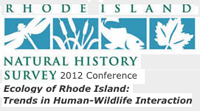
On March 29, 2012, I attended the annual RINHS conference to gain perspective on current trends in human-wildlife interactions from researchers and share notes with researchers on the east coast of the United States.

During March 12-16, 2012, I spent time at the National University of Singapore as an invited academic researcher. After a day-long research trip to the Nanyang Technological University to discuss research in engineering design, I spent four days on the NUS campus lecturing and discussing the design of systems visualization.
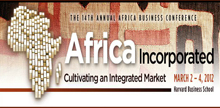
On February 27th, I spent a day at the Harvard Business School, attending a panel on exit strategies for African capital investments. What a special day — to hear everything my sister had accomplished in a fascinating career of building capital investment markets in Africa. So many Africans attending with whom to discuss world events. Our modern world is unique. When else in our history could one so effectively travel to another continent without leaving home?
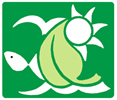
On February 27th, I spent a day at the Rhode Island Compost Conference & Trade Show where knowledgable advisers from outside Rhode Island met with concerned citizens and potential business owners within Rhode Island. We spent the day learning about progress countrywide on all issues of composting and then honed in on issues most relevant to our local communities.

On February 23rd, I spent a day advising the Watershed Counts committee that was working to identify and add metrics to watershed indicators that could help Rhode Island politicians set plans and objectives. The focus of the day's efforts were spent on an Open Space indicator which we deemed useful to elaborate upon for RI's use. The phrase Open Space has been used for years when considering bonds for funding open space conservation and protection.

On February 17th, I spent a day with the Friends of the Moshassuck water council Board of Directors where I have a position as Vice President. We spent the day planning for watershed health for the year: Tree plantings, kayak access points, clean-up efforts, and watershed history discussions were extremely enjoyable as everyone on the board felt a sense of progress and community. Hopefully, similar meetings are taking place all around the globe, and awareness is being spread watershed by watershed.

On January 31st, I spent a day with the Ocean Connectors program in San Diego. We spent the day planting marsh alders (a species endemic to San Diego County) while educating a seventh grade class from Oceanside on the connectivity of watersheds to the ocean. We focused on the health of sea turtles and convinced the youths that the quality of the water coming out of the San Dieguito Lagoon made a difference in the lives of sea turtles in the ocean.

On January 5th, 2012, I visited the New York Foundation in New York City to kick-off a project to coordinate community organizing pedagogy through an on-line community funded by the Community Learning Partnership. It was great to meet new collaborators with such a strong history of helping the under-served organize their communities.

On November 29th, 2011, I attended the Emerging Topics in Environmental Data workshop at the University of Rhode Island Coastal Institute. It was great to meet some more of the environmental data management and visualization community. Dr. Brian Wee is kind enough to share his presentation on-line with our community.

During October 24-28th, I attended the VisWeek 2011 conferences in Providence, RI to network with other visual analytics researchers, get caught up with the latest trends in information and scientific visualization, and co-curate the VisWeek Art Show with Dan Keefe of the University of Minnesota.

During October 12-14th, I attended the Do It With Drupal conference in New York City to network with other content management system developers, get caught up with the latest trends in mobile and social media, and pitch the Watersheds Project mission to attendees. The Drupal community is one of those highly respectful and yet capable open source communities that I have come to enjoy since participating with the Python and Eclipse communities previously.

On September 12th, my fourth year as faculty at RISD begins after a wonderful campus-wide picnic and faculty cocktail hour. I'm excited to update all of my courses as there is a lot going on in a changing Web landscape. This year brings to life new HTML 5 components of the Web Page Design and Dynamic Web Pages courses and continues to promote better coordination of Web content across sites.

On July 25th and 26th, I met with Blue Legacy and The Ocean Foundation in Washington, DC to discuss potential contribution to proposed initiatives developed around watershed health and conservation. The Watersheds Project would contribute on various objectives if funded.
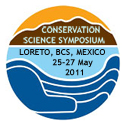
On May 25th, I attended the Conservation Science Symposium in Loreto, Mexico, in order to introduce the WatershedsProject tool platform to those who apply science to the conservation and management of natural resources on the Baja California Peninsula and the Gulf of California. I enjoyed spending time with a couple hundred scientists focusing on projects in the area and getting out on kayak and bicycle before the conference started. See a panoramic QuickTime of the kayaking destination. Having used the carbon to get out west, I decided to check out the Merced and Kings watersheds to do some hiking.
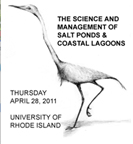
On April 28th, I attended the 14th annual Salt Ponds and Coastal Lagoons Science Symposium with a hundred scientists and educators in Quonset, Rhode Island. I had a feeling the day would reinforce my appreciation and interest in the unique salt ponds of Rhode Island and Buzzard's Bay region of Massachusetts.

On March 26th, 2011, I attended the 8th annual Rhode Island Land and Water Summit which has reached legendary proportion in connecting land trust and water council Rhode Islanders into a cohesive whole of determined conservationists. The day did not disappoint as I networked with so many of the people I have come to respect in our state.

During the week of March 7th, I visited the UM School of Architecture and Computer Science Department to coordinate some activities for VisWeek 2011 in Providence as well as meet with a couple of clients who have significant operations in the Minneapolis area.

As an invited presenter and workshop participant of What Grows On Rhode Island, I participated in the Rhode Island Flower and Garden Show during February 24-27, 2001 to help New Englanders consider the connection between gardening and better watershed quality.
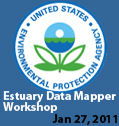
As an invited Director of the Watersheds Project, I attended the EPA's Estuary Data Mapper Workshop on January 27th and February 8th, 2011. The workshop was run out of Narragansett, RI at the Atlantic Ecology Division (AED) headquarters. The EPA continues to work on on-line visual tools for preparing data sets for analysis — including development of input sets to various useful and available earth science modeling tools.

On December 22, 2010, I headed to Washington, DC to sign the paperwork to transfer the Watershed-to-Ocean Initiative from The Ocean Project. The Watersheds Project is officially a tax-deductible project of The Ocean Foundation.

The PhD is official and the dissertation is being published by University of Michigan Press. Both a degree validation (enter Campbell and Bruce in the form) and degree audit are available as proof that it is all official.
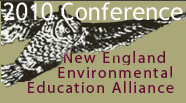
As part of a grant contract, I attended the annual New England Environmental Eduation Alliance conference in Fairlee, VT during October 21-23, 2010. Keynote presentations from Bill McKibben and Dana Hudson highlighted two days of workshopping environmental education themes.

As part of a NOAA grant, I built a visualization system for Clean The Bay so they could track the large debris items they removed from the Narragansett Bay watershed during the summer of 2008. The resulting debris report and mapping service can be used to track all debris removed over many summers. Phase II of the NOAA money aims to create a tide and current visualization for supporting a visual analytics process of guestimating where debris items originate.

As the dissertation writing tasks finish up, I headed to Rangeley, Maine, during the week of August 15th to focus and get some fresh air. Here's a panoramic QuickTime of the top of Bald Mountain, a lovely hike to the top of the Rangeley, Mooselookmeguntic, and Richardson Lakes area. A new disc golf course, Troll Valley also helped me let off some steam.

My third full academic year at RISD ended with me teaching the annual video games with Javascript course. The student projects were fantastic as a final deliverable, but the process of sharing ideas and working together was the real gem. A great group of students who could do anything in the future as a team.

I finished reviewing paper submissions for the IADIS Multi Conference on Computer Science and Information Systems 2010 that took place in Freiburg, Germany during 26 – 31 July 2010 (and also the 2011 conference in Rome). The submissions were informative and the schedule looked great. Sadly, I could attend either of the conferences in person but did make it to Germany in September 2010 for a chance to see extended family instead.

May 18th was a huge day in the lives of the two seniors at Central High School that I had mentored through their senior year theses. Although they had both submitted great written papers on Global Warming and Brain-Computer Interfaces (A+ and B+ respectively), they still had to defend their theses orally with slide presentations — something I remember was extremely stressful back in my high school days. I beamed with pride to see the growth experienced by them both. I hope to get new mentees in the future, but of course that depends on if they independently choose topics of which I am worthy.

To finish presenting a trilogy of dissertation thesis papers, I attended the 7th International Conference on Information Systems for Crisis Response and Management in Seattle, WA on May 4-6, 2010 to present a paper related to our emergency response crisis visualization tool.

For Earth Day 2010, along with presenting again as part of the Florida Virtual School Earth Day lectures, I participated in the Party for the Planet at the Roger Williams Park Zoo in Providence, RI. We spent the day educating children and their parents about watersheds and how they could get involved conserving their local streams.

I headed to Nebraska to meet with my thesis adviser on April 2, 2010. Besides visiting the University of Nebraska in Lincoln and UNO, I accompanied the Audubon Society on the annual Sandhill Cranes migration viewing event and played six most excellent disc golf courses in the area.

I was invited to present at the 11th Pecha Kucha night in Providence, RI on February 16, 2010 to present my vision on using urban and natural systems visualization to promote better community. The house was packed to standing room only as the mayor also presented soon after announcing his candidacy for the house of representatives.

As my one break from dissertation work that winter, I pitched our Watershed-to-Ocean Initiative to the Listen to Your Lakes coordinators at the Shedd Aquarium in Chicago, IL on January 13th, 2010. Based on their valuable feedback, we released a popular on-line demonstration of our tool focused on conservation in the greater Lake Michigan watersheds area.

On November 18th, 2009, I provided a GIS Day workshop at Nathan Bishop Middle School in Providence, RI. GIS Day activities ran all around the world.
 On October 11-15th, I attended the Vis, InfoVis, and VAST conferences in Atlantic City, NJ, to catch up on all the lastest research while reconnecting with my colleagues after missing last year's festivities. Great to see so many alumni from Brown, but no one from the University of Washington.
On October 11-15th, I attended the Vis, InfoVis, and VAST conferences in Atlantic City, NJ, to catch up on all the lastest research while reconnecting with my colleagues after missing last year's festivities. Great to see so many alumni from Brown, but no one from the University of Washington.
 On September 14-17th 2009, I discussed a project update poster at the AZA Annual Conference in Portland, OR, on the one-year anniversary of our first AZA Watershed-to-Ocean Initiative presentation to the zoo and aquarium community.
On September 14-17th 2009, I discussed a project update poster at the AZA Annual Conference in Portland, OR, on the one-year anniversary of our first AZA Watershed-to-Ocean Initiative presentation to the zoo and aquarium community.
 On June 8th, 2009 (and again in 2010), I coordinated the World Oceans Day event list for the world. World Oceans Day has been proclaimed by the United Nations as officially June 8th every year. I wore blue in the honor of the world ocean and attended a local event in Providence.
On June 8th, 2009 (and again in 2010), I coordinated the World Oceans Day event list for the world. World Oceans Day has been proclaimed by the United Nations as officially June 8th every year. I wore blue in the honor of the world ocean and attended a local event in Providence.
 On June 6-7, 2009, I participated in the sustainable living festival held annually at the Apeiron Institute for Sustainable Living (manned a booth on behalf of the ocean and The Ocean Project). The festival is a very hopeful event for those who believe the state of Rhode Island is poised to be a leading state in the development of green technologies. The demonstration house is fantastic and Brad is the best director I could imagine for running that place. Dar Williams rewarded us greatly at the end of the first day of heavy networking and visioning.
On June 6-7, 2009, I participated in the sustainable living festival held annually at the Apeiron Institute for Sustainable Living (manned a booth on behalf of the ocean and The Ocean Project). The festival is a very hopeful event for those who believe the state of Rhode Island is poised to be a leading state in the development of green technologies. The demonstration house is fantastic and Brad is the best director I could imagine for running that place. Dar Williams rewarded us greatly at the end of the first day of heavy networking and visioning.
 On June 4th, 2009 I celebrated the exciting renaming of our newly established Industrial & Systems Engineering department at the University of Washington. After working thirteen years in the Industrial Engineering department on studying, understanding, and improving both natural (ocean and watershed-based ecosystem) and man-made processes, I am so proud to have the word Systems added to our name. We truly have been doing work on modeling and simulating systems of all types within the department and we surely deserved to get our own structure independent of the mechanical engineering department that helped spin us off years ago. Sometimes holding out a bit on big life events pays off - my doctoral degree will now officially be granted within the new department jurisdiction — A proud day for all faculty, administrators, students, and alumni!
On June 4th, 2009 I celebrated the exciting renaming of our newly established Industrial & Systems Engineering department at the University of Washington. After working thirteen years in the Industrial Engineering department on studying, understanding, and improving both natural (ocean and watershed-based ecosystem) and man-made processes, I am so proud to have the word Systems added to our name. We truly have been doing work on modeling and simulating systems of all types within the department and we surely deserved to get our own structure independent of the mechanical engineering department that helped spin us off years ago. Sometimes holding out a bit on big life events pays off - my doctoral degree will now officially be granted within the new department jurisdiction — A proud day for all faculty, administrators, students, and alumni!
 During May 19-24, 2009, I presented a poster entitled Watershed to Ocean: Personal Connections to the Ocean Through On-line Interactive Experiences at the International Marine Conservation Congress at George Mason University near Washington, DC. My presentation followed-up on the work introduced in Shanghai and invited other North American watershed stakeholders to participate in our grass roots, watershed quality social-networking through visual literacy, process.
During May 19-24, 2009, I presented a poster entitled Watershed to Ocean: Personal Connections to the Ocean Through On-line Interactive Experiences at the International Marine Conservation Congress at George Mason University near Washington, DC. My presentation followed-up on the work introduced in Shanghai and invited other North American watershed stakeholders to participate in our grass roots, watershed quality social-networking through visual literacy, process.
 On May 6, 2009, Renee Grinnell and I attended a Conservation Development Workshop at the RI Department of Environmental Management in Providence, RI. We represented The Ocean Project, but really we represented our interests as public citizens as we learned about the current process to conserve a parcel of land. We learned about the organizations that help a citizen promote conservation. We learned about the software available to map a targeted conservation area in ways that promote the benefits of conservation. And, we all divided into four teams to practice the process on a recently conserved residential zone. I must say that the Blue Team's proposal was the best — no doubt because we had the most diverse group of citizens working together of all the teams. I wish everyone would attend such a workshop if only to get conservation themes on their radar.
On May 6, 2009, Renee Grinnell and I attended a Conservation Development Workshop at the RI Department of Environmental Management in Providence, RI. We represented The Ocean Project, but really we represented our interests as public citizens as we learned about the current process to conserve a parcel of land. We learned about the organizations that help a citizen promote conservation. We learned about the software available to map a targeted conservation area in ways that promote the benefits of conservation. And, we all divided into four teams to practice the process on a recently conserved residential zone. I must say that the Blue Team's proposal was the best — no doubt because we had the most diverse group of citizens working together of all the teams. I wish everyone would attend such a workshop if only to get conservation themes on their radar.
 On April 22, 2009, as part of the Virtual Earth Day program in the Florida Public Schools, I presented a vision of a watershed quality improvement process driven by community efforts sponsored by local zoos, aquariums, museums, and conservation organizations. We used the Elluminate online software to share ideas and discuss the future of our planet through a lifelong student commitment to participation in good environmental management for the benefit of our world ocean.
On April 22, 2009, as part of the Virtual Earth Day program in the Florida Public Schools, I presented a vision of a watershed quality improvement process driven by community efforts sponsored by local zoos, aquariums, museums, and conservation organizations. We used the Elluminate online software to share ideas and discuss the future of our planet through a lifelong student commitment to participation in good environmental management for the benefit of our world ocean.
 During April 13-17, 2009, I presented a paper entitled Training for emergency response with RimSim:Response! at the SPIE Defense, Security, and Sensing Conference in Orlando. We have the opportunity to modify our emergency response visualization tool to look at issues in military logistics related to distributed cognition across multiple jurisdictions and, as a result, presented our experiments with agent simulation at the conference.
During April 13-17, 2009, I presented a paper entitled Training for emergency response with RimSim:Response! at the SPIE Defense, Security, and Sensing Conference in Orlando. We have the opportunity to modify our emergency response visualization tool to look at issues in military logistics related to distributed cognition across multiple jurisdictions and, as a result, presented our experiments with agent simulation at the conference.
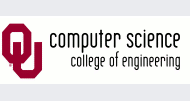 During March 23-28, 2009, I attended the AZA Mid-year Meeting in Oklahoma City and visited Chris Weaver at his new digs at the University of Oklahoma School of Engineering in Norman. I had planned on running a workshop on the Ocean Project's Watershed-Ocean Initiative and convincing more of our partners to provide resources for developing visualizations for their regional watershed(s). But, the workshop got cancelled as collaborators were not willing to fund travel at this time. I caught up with Chris on his Improvise work and presented at an academic seminar while in town.
During March 23-28, 2009, I attended the AZA Mid-year Meeting in Oklahoma City and visited Chris Weaver at his new digs at the University of Oklahoma School of Engineering in Norman. I had planned on running a workshop on the Ocean Project's Watershed-Ocean Initiative and convincing more of our partners to provide resources for developing visualizations for their regional watershed(s). But, the workshop got cancelled as collaborators were not willing to fund travel at this time. I caught up with Chris on his Improvise work and presented at an academic seminar while in town.
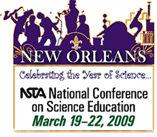 During March 19-23, 2009, I presented a paper entitled Exploring watersheds and conservation action using a Web-based, interactive application at the National Science Teachers Association Annual Conference in New Orleans. My presentation ran right after the first keynote on March 19th. I had always wanted to attend the NSTA annual conference because I've met so many inspired colleagues at the UW who come back from the conference all hopeful and fired up with enthusiasm for teaching (and learning since you can't teach without learning) science.
During March 19-23, 2009, I presented a paper entitled Exploring watersheds and conservation action using a Web-based, interactive application at the National Science Teachers Association Annual Conference in New Orleans. My presentation ran right after the first keynote on March 19th. I had always wanted to attend the NSTA annual conference because I've met so many inspired colleagues at the UW who come back from the conference all hopeful and fired up with enthusiasm for teaching (and learning since you can't teach without learning) science.
 As part of the Spring conference tour, I spent four days in El Paso, Texas visiting with our border security project friends in the School of Business and Institute of Defense and Security. Thanks to Richard Posthuma for making my visit so pleasant and worthwhile. I spent the following two days in the Big Bend Ranch State Park hiking through the desert along the southern ridge of the Rio Grande valley — feeling a little strange about there being such a significant world border there when there was nothing in sight to suggest such a status. I did not encounter a single border control agent, but had been warned to be on my best behavior had I done so.
As part of the Spring conference tour, I spent four days in El Paso, Texas visiting with our border security project friends in the School of Business and Institute of Defense and Security. Thanks to Richard Posthuma for making my visit so pleasant and worthwhile. I spent the following two days in the Big Bend Ranch State Park hiking through the desert along the southern ridge of the Rio Grande valley — feeling a little strange about there being such a significant world border there when there was nothing in sight to suggest such a status. I did not encounter a single border control agent, but had been warned to be on my best behavior had I done so.
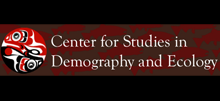 My RA responsibilities changed as I received an offer to work with Mark Haselkorn within the National center for Border Security and Immigration (NCBSI) construct he had been organizing with colleagues at UTEP and Wayne State University. My role required me to contribute useful work at the center for Studies in Demography and Ecology within the UW community. I continued to work my Research Scientist position minimally to keep health benefits — and looked forward to potential work with the Seattle Port Authority should a large proposal working with the port and regional Coast Guard hit the mark.
My RA responsibilities changed as I received an offer to work with Mark Haselkorn within the National center for Border Security and Immigration (NCBSI) construct he had been organizing with colleagues at UTEP and Wayne State University. My role required me to contribute useful work at the center for Studies in Demography and Ecology within the UW community. I continued to work my Research Scientist position minimally to keep health benefits — and looked forward to potential work with the Seattle Port Authority should a large proposal working with the port and regional Coast Guard hit the mark.
Turnover at the US Coast Guard significantly hurt our chances of getting a grant going while I worked as an RA. And yet, the RA appointment gave me an interesting domain to apply my talents as I accumulated the necessary dissertation credits required of a PhD degree. My biggest contribution was as the JavaScript programmer and Web developer for the Nepal Economic Corridor Mapping visualization we built for a client.
 As of January 1, 2009, the year has turned and we are in the midst of some hyped changes in our society. I figured I might as well make some changes myself. I hadn't been taking full advantage of my PhC designation (which Miles reminded me is a big deal at the UW Ocean Sciences Christmas party) which was conferred to me upon passing my General Exam. Well, the time seems ripe as I am on a roll with seven of my last papers being accepted for publication, our RVAC seed funding behind us and I have 27 dissertation credits to accumulate before I can be given my PhD degree. So, I am spending the next two quarters as a full-time graduate student which comes in nicely for all the conferences fees I must pay to present papers during the Spring conference season.
As of January 1, 2009, the year has turned and we are in the midst of some hyped changes in our society. I figured I might as well make some changes myself. I hadn't been taking full advantage of my PhC designation (which Miles reminded me is a big deal at the UW Ocean Sciences Christmas party) which was conferred to me upon passing my General Exam. Well, the time seems ripe as I am on a roll with seven of my last papers being accepted for publication, our RVAC seed funding behind us and I have 27 dissertation credits to accumulate before I can be given my PhD degree. So, I am spending the next two quarters as a full-time graduate student which comes in nicely for all the conferences fees I must pay to present papers during the Spring conference season.
 On December 29th 2008, I spent a day visiting the Community Learning Partnership in Washington, DC. We reviewed the latest working papers that are being distributed widely in order to build a worldwide network of community change specialists - those who can help inner-city communities build community change leaders from within through support and practical educational opportunities.
On December 29th 2008, I spent a day visiting the Community Learning Partnership in Washington, DC. We reviewed the latest working papers that are being distributed widely in order to build a worldwide network of community change specialists - those who can help inner-city communities build community change leaders from within through support and practical educational opportunities.
 On November 14th 2008, I participated in the Reaching out to Residents workshop at the University of Rhode Island - coordinated by the NEMO Cooperative Program. Along with both watershed council representatives and goverment officials, we workshopped ideas on how best to work together while focusing on the largest threat to our shared water quality: Nonpoint polution from citizens and businesses. The workshop was wonderfully planned and executed and I got a real sense of how watershed councils, town governments, and state government organizations can work together (and how far our humble beginnings have grown to date). Stormwater cleanliness and diversion is a great topic to bring people together from various walks of life - it is time Rhode Islanders caught up with our Massachusetts neighbors in this regard.
On November 14th 2008, I participated in the Reaching out to Residents workshop at the University of Rhode Island - coordinated by the NEMO Cooperative Program. Along with both watershed council representatives and goverment officials, we workshopped ideas on how best to work together while focusing on the largest threat to our shared water quality: Nonpoint polution from citizens and businesses. The workshop was wonderfully planned and executed and I got a real sense of how watershed councils, town governments, and state government organizations can work together (and how far our humble beginnings have grown to date). Stormwater cleanliness and diversion is a great topic to bring people together from various walks of life - it is time Rhode Islanders caught up with our Massachusetts neighbors in this regard.
 On October 30th and 31st 2008, I participated as a host at the inaugural UW conference on Safety and Security Research and Education in Seattle, WA. Along with my PARVAC colleagues, we discussed the long-term relevance of our RimSim:Response! emergency preparedness simulator with an interested audience of community emergency response personnel.
On October 30th and 31st 2008, I participated as a host at the inaugural UW conference on Safety and Security Research and Education in Seattle, WA. Along with my PARVAC colleagues, we discussed the long-term relevance of our RimSim:Response! emergency preparedness simulator with an interested audience of community emergency response personnel.
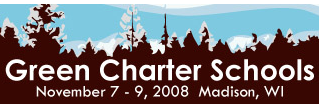 On November 7-9th 2008, I promoted ocean awareness and conservation in education curriculum at the Green Charter Schools Conference in Madison, WI. We shared our vision and game plan to promote better coordination of ocean awareness and conservation themes incorporated into collaborations between schools and local zoos, aquariums, museums, and conservation organizations.
On November 7-9th 2008, I promoted ocean awareness and conservation in education curriculum at the Green Charter Schools Conference in Madison, WI. We shared our vision and game plan to promote better coordination of ocean awareness and conservation themes incorporated into collaborations between schools and local zoos, aquariums, museums, and conservation organizations.
 On October 21, 2008, I presented a paper and demonstration of the Watershed-Ocean Initiative of The Ocean Project at the International Aquarium Congress in Shanghai. A significant majority of all interested aquarium owners and management in the world attended the congress which occurs every four years. The conference focused on collaboration between east and west and seemed to be a wee bit conservative - likely due to a language barrier that was only partially compensated for by real-time translation services for English, Chinese, and Japanese. Although my session was attended by a who's who in big name aquarium mover and shakers, it lacked attendance by the middle management tier for which my work might be best suited. I am hopeful that our paper will trickle down in the various institutions over time.
On October 21, 2008, I presented a paper and demonstration of the Watershed-Ocean Initiative of The Ocean Project at the International Aquarium Congress in Shanghai. A significant majority of all interested aquarium owners and management in the world attended the congress which occurs every four years. The conference focused on collaboration between east and west and seemed to be a wee bit conservative - likely due to a language barrier that was only partially compensated for by real-time translation services for English, Chinese, and Japanese. Although my session was attended by a who's who in big name aquarium mover and shakers, it lacked attendance by the middle management tier for which my work might be best suited. I am hopeful that our paper will trickle down in the various institutions over time.
 Bill Mott and I participated in an interactive panel entitled Sustainable Oceans - A Future in Question at the 2008 Association of Zoos and Aquariums Annual Conference in Milwaukee, WI in September. We presented the vision for our Watershed-Ocean Initiative and answered questions from our current partners and interested new partners. New relationships were formed which will lead to collaborative work on our visualization for personal action framework.
Bill Mott and I participated in an interactive panel entitled Sustainable Oceans - A Future in Question at the 2008 Association of Zoos and Aquariums Annual Conference in Milwaukee, WI in September. We presented the vision for our Watershed-Ocean Initiative and answered questions from our current partners and interested new partners. New relationships were formed which will lead to collaborative work on our visualization for personal action framework.
 June 7th and 8th at the Rhode Island Sustainable Living Festival in Coventry, RI gave me the wonderful honor of moderating a panel entitled Building Real World Communities via the Internet with fellow panelists Angela Penn of The Ocean Project, Sue Korte (the Providential Gardener), keeper of What Grows On in Rhode Island, and Caroline Brown, writer of the Earth Friendly Gardening blog. See a picture of us after we spoke.
June 7th and 8th at the Rhode Island Sustainable Living Festival in Coventry, RI gave me the wonderful honor of moderating a panel entitled Building Real World Communities via the Internet with fellow panelists Angela Penn of The Ocean Project, Sue Korte (the Providential Gardener), keeper of What Grows On in Rhode Island, and Caroline Brown, writer of the Earth Friendly Gardening blog. See a picture of us after we spoke.
 The Spring Visual Analytics Consortium Meeting took place in the Washington, DC suburbs at the Johns Hopkins Applied Physics Laboratory this May 20-22, 2008. Suzanne Weghorst, Onur Mete, and I showed off a resource allocation game for first responder coordinators to play given different authority and responsibility levels. The application ran repeatedly without failure with participants in Seattle and Maryland.
The Spring Visual Analytics Consortium Meeting took place in the Washington, DC suburbs at the Johns Hopkins Applied Physics Laboratory this May 20-22, 2008. Suzanne Weghorst, Onur Mete, and I showed off a resource allocation game for first responder coordinators to play given different authority and responsibility levels. The application ran repeatedly without failure with participants in Seattle and Maryland.
 Onur Mete and I presented a paper recap poster at the 2008 2008 IEEE International Conference on Technologies for Homeland Security during May 12-13, 2008 in the Boston, MA area. The meeting had a real regional feel to it with only one other fellow researcher from our RVAC circles in attendance. We noticed an obvious lack of focus among the participants and wondered if the lack of an RVAC in the vacinity could have anything to do with it? I mean, could RVACs really be helping focus regions on tasks?
Onur Mete and I presented a paper recap poster at the 2008 2008 IEEE International Conference on Technologies for Homeland Security during May 12-13, 2008 in the Boston, MA area. The meeting had a real regional feel to it with only one other fellow researcher from our RVAC circles in attendance. We noticed an obvious lack of focus among the participants and wondered if the lack of an RVAC in the vacinity could have anything to do with it? I mean, could RVACs really be helping focus regions on tasks?
 Three days at PNNL for the semi-annual Visualization and Analytics Consortium Meeting during November 13-15, 2007 in Richland, Washington let me show off our latest RimSim version which has been refactored to work well with a multi-user agent framework. The PARVAC RimSim contribution is documented in a poster (31 MB) we shared with sixty attendees of the meeting.
Three days at PNNL for the semi-annual Visualization and Analytics Consortium Meeting during November 13-15, 2007 in Richland, Washington let me show off our latest RimSim version which has been refactored to work well with a multi-user agent framework. The PARVAC RimSim contribution is documented in a poster (31 MB) we shared with sixty attendees of the meeting.
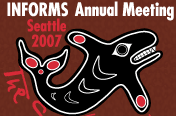
Five days at the INFORMS annual conference in Seattle during November 3-7, 2007 gave me the opportunity to interact with optimization mathematicians, game theory investigators, and simulation specialists. Suzanne Weghorst and I presented our RimSim application to a small community of emergency response logicians.
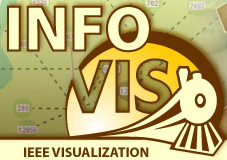 Five days at the 2007 InfoVis/Vis/VAST Conference Series during Oct 26-Nov 1, 2007 in Sacramento gave me the opportunity to participate in the Doctoral Colloquium and catch up with all the latest research and developments in the information visualization analysis and presentation fields. Of note was the groundswell of public interest in socially-mediated infovis discussions accessible via the Web.
Five days at the 2007 InfoVis/Vis/VAST Conference Series during Oct 26-Nov 1, 2007 in Sacramento gave me the opportunity to participate in the Doctoral Colloquium and catch up with all the latest research and developments in the information visualization analysis and presentation fields. Of note was the groundswell of public interest in socially-mediated infovis discussions accessible via the Web.
 Four days at Michigan Tech's Civil and Environmental Engineering department during August 22-25, 2007 let me ponder the application of agent-based simulation frameworks to emergency response planning and training modules. My host, Amlan Mukherjee, provided spirited debate and the opportunity to hike the Keweenaw Peninsula and sail Portage Lake. I look forward to integrating and helping improve the framework obtained.
Four days at Michigan Tech's Civil and Environmental Engineering department during August 22-25, 2007 let me ponder the application of agent-based simulation frameworks to emergency response planning and training modules. My host, Amlan Mukherjee, provided spirited debate and the opportunity to hike the Keweenaw Peninsula and sail Portage Lake. I look forward to integrating and helping improve the framework obtained.
 I finished my Masters in Industrial Engineering degree on June 8, 2007. My focus was on human-computing interfaces with a specialty in virtual reality systems. As a result, my transcript is guaranteed to be unique with a mix of industrial engineering (IND E), computer science (CSE), and technical communications (T C) specific to my interests in computer-mediated communication interfaces.
I finished my Masters in Industrial Engineering degree on June 8, 2007. My focus was on human-computing interfaces with a specialty in virtual reality systems. As a result, my transcript is guaranteed to be unique with a mix of industrial engineering (IND E), computer science (CSE), and technical communications (T C) specific to my interests in computer-mediated communication interfaces.
 Three days at the semi-annual Visualization and Analytics Consortium Meeting during May 14-16, 2007 in Bellevue, Washington let me show off our latest RimSim vision and participate with peers and customers from around the country. Our contribution is documented in a poster that was presented at the 2007 Homeland Security Science & Technology Stakeholders Conference at the Ronald Reagan International Trade center in Washington DC during May 21-24, 2007.
Three days at the semi-annual Visualization and Analytics Consortium Meeting during May 14-16, 2007 in Bellevue, Washington let me show off our latest RimSim vision and participate with peers and customers from around the country. Our contribution is documented in a poster that was presented at the 2007 Homeland Security Science & Technology Stakeholders Conference at the Ronald Reagan International Trade center in Washington DC during May 21-24, 2007.

 Three days at the Science + Society Conference during January 19-21, 2007 in Boston drove home many concerns about the future of science with regards to the awareness and coordination of society's participation. From astronomy to medical sciences to earth sciences, data is coming in from the far reaches of the globe and yet the numbers of people competent to manage and investigate it is minimal. Are we funding science properly? How can we better invite the general public to go along for the ride?
Three days at the Science + Society Conference during January 19-21, 2007 in Boston drove home many concerns about the future of science with regards to the awareness and coordination of society's participation. From astronomy to medical sciences to earth sciences, data is coming in from the far reaches of the globe and yet the numbers of people competent to manage and investigate it is minimal. Are we funding science properly? How can we better invite the general public to go along for the ride?
A week spent between the Purdue University and Indiana University campuses in early December 2006 reaffirmed my memories of the hospitable midwest and let me meet with twenty different project groups working on visual analytics related work. Visualization, information processing, agent-based simulation, and distributed cognition analysis are just some of the areas covered by the trip.

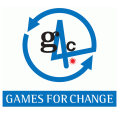
 Three days at the Penn State NEVAC-GeoVISTA center during August 6-8, 2006 let me engage in meaningful discussions regarding the temporal and geospatial presentation of data as it relates to visual analytics. Chris Weaver's Improvise software quickly became the focus of my interests. Chris' open sharing of ideas and his collegial friendship which he provided in those emotional days after my dear cat's death made the trip more than just a work and academic exercise.
Three days at the Penn State NEVAC-GeoVISTA center during August 6-8, 2006 let me engage in meaningful discussions regarding the temporal and geospatial presentation of data as it relates to visual analytics. Chris Weaver's Improvise software quickly became the focus of my interests. Chris' open sharing of ideas and his collegial friendship which he provided in those emotional days after my dear cat's death made the trip more than just a work and academic exercise.
 I attended SIGGRAPH 2006, in Boston during August 1-3, 2006, as a joyous farewell to the SIGGRAPH community. I had no responsibilities except to host a dozen or so good friends in Boston and invite them to visit my house in Providence, RI. I probably had the most exhausting SIGGRAPH by paying my own way, seeing every item of interest possible, and spending it socializing with a significant percentage of the computer graphics community. For once, I waited until after the conference to start reading the proceedings.
I attended SIGGRAPH 2006, in Boston during August 1-3, 2006, as a joyous farewell to the SIGGRAPH community. I had no responsibilities except to host a dozen or so good friends in Boston and invite them to visit my house in Providence, RI. I probably had the most exhausting SIGGRAPH by paying my own way, seeing every item of interest possible, and spending it socializing with a significant percentage of the computer graphics community. For once, I waited until after the conference to start reading the proceedings. At the 2006 Visual Analytics Consortium meeting at Stanford University during May 22-25, 2006, I participated in member organization presentations aimed at building consensus and collaboration as to our approach of applying visual analytics to the pressing information age issue of information overload (think pollution early in the industrial age).
At the 2006 Visual Analytics Consortium meeting at Stanford University during May 22-25, 2006, I participated in member organization presentations aimed at building consensus and collaboration as to our approach of applying visual analytics to the pressing information age issue of information overload (think pollution early in the industrial age). At EclipseCon 2006 in Santa Clara, CA during March 19-24, our software development team received an impressive upgrade in understanding where the sophistication of open source development rationale and methodology has reached. Open source methods for commodity software are thriving through a transparent community process. Having spent a day side-tripping up to the DigitBarn Computer Museum, and realizing how open source was an absolute necessity back in the days of mainframe time sharing, I'm committed to supporting open source as much as possible during the day job.
At EclipseCon 2006 in Santa Clara, CA during March 19-24, our software development team received an impressive upgrade in understanding where the sophistication of open source development rationale and methodology has reached. Open source methods for commodity software are thriving through a transparent community process. Having spent a day side-tripping up to the DigitBarn Computer Museum, and realizing how open source was an absolute necessity back in the days of mainframe time sharing, I'm committed to supporting open source as much as possible during the day job.
 As the University of Washington was awarded one of five Regional Visualization and Analysis center by the National Visualization and Analysis center, I attended the RVAC kick-off meetings in Salt Lake City on January 5-7, 2006. The centers will perform research and work on an education plan for applying visual analytics science to all aspects of emergency response to better perform under conditions of urgency and stress. The PARVAC (Pacific Area RVAC) will connect academic, government, and industry centers around the Pacific Rim in collaborating on visual analytics tools and their use.
As the University of Washington was awarded one of five Regional Visualization and Analysis center by the National Visualization and Analysis center, I attended the RVAC kick-off meetings in Salt Lake City on January 5-7, 2006. The centers will perform research and work on an education plan for applying visual analytics science to all aspects of emergency response to better perform under conditions of urgency and stress. The PARVAC (Pacific Area RVAC) will connect academic, government, and industry centers around the Pacific Rim in collaborating on visual analytics tools and their use.
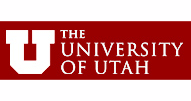 On January 8th, 2006, as a follow-on to the RVAC kick-off meetings, I wandered up into the mountains for a day to walk the ten miles it took to reach well past the snowline. Amazingly, I met no one on the walk on a Friday afternoon - I was walking in that great time of day when the shadows get longer and the sun creeps into the end of day haze - and at a change in altitude that brought me from early fall to early winter in surroundings. By the time I was halfway back down, I could see the lights of Salt Lake City coming on one after the other in rapid succession. Hard to believe the contrast between discussing terrorism and natural disasters for two solid days and then a day at peace up in Parley's Canyon. As I realized leaving in that blissful mood would defeat my purpose for the paid trip, I spent the night investigating the emergency response services at the University of Utah Healthcare center — an amazing place with bright red helicopters arriving twice with emergency injuries (sufferred on the ski slopes, I imagined). The facilities looked so new and the people were all so serious in their demeanor as I tried to strike up conversations that would be more pleasant for their Friday night at work. By the end of it all, I wasn't sure where the NVAC-RVAC partnerships were headed, but I was willing to give it a try for the first three years' agenda.
On January 8th, 2006, as a follow-on to the RVAC kick-off meetings, I wandered up into the mountains for a day to walk the ten miles it took to reach well past the snowline. Amazingly, I met no one on the walk on a Friday afternoon - I was walking in that great time of day when the shadows get longer and the sun creeps into the end of day haze - and at a change in altitude that brought me from early fall to early winter in surroundings. By the time I was halfway back down, I could see the lights of Salt Lake City coming on one after the other in rapid succession. Hard to believe the contrast between discussing terrorism and natural disasters for two solid days and then a day at peace up in Parley's Canyon. As I realized leaving in that blissful mood would defeat my purpose for the paid trip, I spent the night investigating the emergency response services at the University of Utah Healthcare center — an amazing place with bright red helicopters arriving twice with emergency injuries (sufferred on the ski slopes, I imagined). The facilities looked so new and the people were all so serious in their demeanor as I tried to strike up conversations that would be more pleasant for their Friday night at work. By the end of it all, I wasn't sure where the NVAC-RVAC partnerships were headed, but I was willing to give it a try for the first three years' agenda.
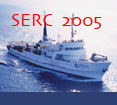 I attended the Teaching About the Ocean System Using New Research Techniques: Data, Models and Visualization workshop in Seattle, Washington on July 6-9, 2005. Never before had I spent such a useful stretch of time with a mix of educators, graphic artists, information scientists, and computer scientists as we discussed the future of education as designed for the frontal cortex. I participated in many workshopping excercises from which a report was generated as part of the Cutting Edge program sponsored by NSF. Kudos to Carelton College for organizing the workshop and the UW for doing a splendid job as host.
I attended the Teaching About the Ocean System Using New Research Techniques: Data, Models and Visualization workshop in Seattle, Washington on July 6-9, 2005. Never before had I spent such a useful stretch of time with a mix of educators, graphic artists, information scientists, and computer scientists as we discussed the future of education as designed for the frontal cortex. I participated in many workshopping excercises from which a report was generated as part of the Cutting Edge program sponsored by NSF. Kudos to Carelton College for organizing the workshop and the UW for doing a splendid job as host.
 At the OpenMI Workshop in Munich, Germany on September 27-29, 2005, I participated in a discussion entitled Experiences with OpenMI that looked at how earth science simulation proponents (specifically hydrology modelers) were using the popular European OpenMI (open modeling interface) specification to link models for more complex analyses.
At the OpenMI Workshop in Munich, Germany on September 27-29, 2005, I participated in a discussion entitled Experiences with OpenMI that looked at how earth science simulation proponents (specifically hydrology modelers) were using the popular European OpenMI (open modeling interface) specification to link models for more complex analyses.
 At the Python National Convention in Washington DC, during March 22-25, 2005, I ran a paper presentation panel looking at the use of Python visualization in improving application usability. The whole conference was run through a Wiki that I updated often to participate with my take on scripting and visualization platforms. Fascinating to watch the Wiki change shape as the conference unfolded, but a Wiki-approach is only as good as those who participate in it. Nice job, everyone!
At the Python National Convention in Washington DC, during March 22-25, 2005, I ran a paper presentation panel looking at the use of Python visualization in improving application usability. The whole conference was run through a Wiki that I updated often to participate with my take on scripting and visualization platforms. Fascinating to watch the Wiki change shape as the conference unfolded, but a Wiki-approach is only as good as those who participate in it. Nice job, everyone!
 Six months in New Zealand helped me put a dissertation prospectus together. I provide it on-line as Collaborative 4-D Virtual Environments for Time-based Consensus. Time away from Seattle provided a wonderful time to dream of possible research directions. My accepted proposal was nowhere as cool as this original (see the abstract at the bottom).
Six months in New Zealand helped me put a dissertation prospectus together. I provide it on-line as Collaborative 4-D Virtual Environments for Time-based Consensus. Time away from Seattle provided a wonderful time to dream of possible research directions. My accepted proposal was nowhere as cool as this original (see the abstract at the bottom). At the August 2004 Virtual Worlds Consortium, Mark Stoermer and I presented an investigation of undersea earthquake data below the Endeavour Ridge in the northeast Pacific Ocean. A GeoWall-based presentation of the data provided the audience a unique visualization for thinking about the timing and distribution of quakes caused by tectonic plate interaction. A picture here. We presented Amazon basin remote sensing data as well on the GeoWall to highlight land use patterns.
At the August 2004 Virtual Worlds Consortium, Mark Stoermer and I presented an investigation of undersea earthquake data below the Endeavour Ridge in the northeast Pacific Ocean. A GeoWall-based presentation of the data provided the audience a unique visualization for thinking about the timing and distribution of quakes caused by tectonic plate interaction. A picture here. We presented Amazon basin remote sensing data as well on the GeoWall to highlight land use patterns.
 While at the University of Canterbury, I had the distinct honor and pleasure of attending the Symposium on the Politics of Antarctica for three days of awareness building and discussion of the state and management of Antarctica. Many of the graduate students involved were part of the program that took them to Antarctica for six days of experience. I was impressed with the quality of imagery included in the various presentations.
While at the University of Canterbury, I had the distinct honor and pleasure of attending the Symposium on the Politics of Antarctica for three days of awareness building and discussion of the state and management of Antarctica. Many of the graduate students involved were part of the program that took them to Antarctica for six days of experience. I was impressed with the quality of imagery included in the various presentations.
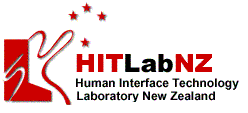 From October 15, 2003 through April 15, 2004, I provided consulting services to the HIT Lab
located at the University of Canterbury in Christchurch, New Zealand. Tasks included working
on an Access Grid node for potential around the clock connectivity
between the HIT Lab US and HIT Lab NZ and building a GeoWall node
for investigation of 4-D earth science datasets. Formal conference presentations included:
From October 15, 2003 through April 15, 2004, I provided consulting services to the HIT Lab
located at the University of Canterbury in Christchurch, New Zealand. Tasks included working
on an Access Grid node for potential around the clock connectivity
between the HIT Lab US and HIT Lab NZ and building a GeoWall node
for investigation of 4-D earth science datasets. Formal conference presentations included:
- Geographical Information Systems and Augmented Reality: A Keynote Address, 15th Annual Colloquium of the Spatial Information Research Centre, University of Otago, Dunedin, New Zealand, December 2, 2003
- Information Visualisation Techniques for the GeoWall: A Workshop, Australasian Symposium on Information Visualisation, University of Canterbury, Christchurch, New Zealand, January 24, 2004.
- Information Visualisation Techniques for the GeoWall: Emerging Technologies Exhibit, APEC Science Ministers' Meeting, Christchurch, New Zealand, March 10-11, 2004.
 At the August 2003 Virtual Worlds Consortium, I demonstrated the first application built using our home-grown OpenGL-based blue visualization engine. The application allowed a participant to drive an underwater autonomous vehicle by using hand gestures on top of the HI-SPACE table, which also presented a blue-based visualization. The application control panel allowed each pilot to change boyancy, direction, thrust, and perspective with easy gestures atop the HI-SPACE table.
At the August 2003 Virtual Worlds Consortium, I demonstrated the first application built using our home-grown OpenGL-based blue visualization engine. The application allowed a participant to drive an underwater autonomous vehicle by using hand gestures on top of the HI-SPACE table, which also presented a blue-based visualization. The application control panel allowed each pilot to change boyancy, direction, thrust, and perspective with easy gestures atop the HI-SPACE table. During March 20-28, 2003, I worked with two PhD candidates at the Information and Communications University in Taejon, South Korea. After their successful visit to the HIT Lab during Summer 2001 to connect their ATLAS high volume, multi-user communications package to our Virtual Playground 3-D visualization client, we both decided to focus on a C/C++ implementation whereby ATLAS would connect to our BlueSpace visualization engine in similar fashion to GreenSpace communications. I also presented at a computer science seminar series on campus. Short trip journal here.
During March 20-28, 2003, I worked with two PhD candidates at the Information and Communications University in Taejon, South Korea. After their successful visit to the HIT Lab during Summer 2001 to connect their ATLAS high volume, multi-user communications package to our Virtual Playground 3-D visualization client, we both decided to focus on a C/C++ implementation whereby ATLAS would connect to our BlueSpace visualization engine in similar fashion to GreenSpace communications. I also presented at a computer science seminar series on campus. Short trip journal here. At the October 2002 Virtual Worlds Consortium, I presented the first application prototype for BlueSpace, an ocean-centric perspective of sharing data and experience in a Web-based, multi-participant environment. Based on GreenSpace's ideals for a shared electronic meetingspace, BlueSpace presented a virtual marine life tank networked between a Java 3D desktop application and an ARToolKit augmented reality rendition.
A picture here.
At the October 2002 Virtual Worlds Consortium, I presented the first application prototype for BlueSpace, an ocean-centric perspective of sharing data and experience in a Web-based, multi-participant environment. Based on GreenSpace's ideals for a shared electronic meetingspace, BlueSpace presented a virtual marine life tank networked between a Java 3D desktop application and an ARToolKit augmented reality rendition.
A picture here.



 During May 24-27, 2002 I attended my last of five consecutive WisCon conferences in Madison, WI. So much of that last conference was affected by the passing of the Patriot Act — discussion of which seemed to invade every presentation and workshop. The conference had allowed me to stay connected with Madison while I got used to Seattle and had helped me gain a voice for writing fiction while absorbing many poignant discussions about the role of feminism in science fiction writing. I had found the writings of Isaac Asimov demeaning to women, but had enjoyed reading his stories just the same. The highlight of the five conferences for me was workshopping a story of mine and eight other people with Heinz Fenkl. I enjoyed meeting so many authors I enjoyed reading upon listening to discussions about their work.
During May 24-27, 2002 I attended my last of five consecutive WisCon conferences in Madison, WI. So much of that last conference was affected by the passing of the Patriot Act — discussion of which seemed to invade every presentation and workshop. The conference had allowed me to stay connected with Madison while I got used to Seattle and had helped me gain a voice for writing fiction while absorbing many poignant discussions about the role of feminism in science fiction writing. I had found the writings of Isaac Asimov demeaning to women, but had enjoyed reading his stories just the same. The highlight of the five conferences for me was workshopping a story of mine and eight other people with Heinz Fenkl. I enjoyed meeting so many authors I enjoyed reading upon listening to discussions about their work.
 I represented the Virtual Big Beef Creek project team at the 2002 Web 3D Symposium in Tempe, Arizona during February 2002. See a picture. The Web 3D XML specification was discussed at length at the conference. It shows such promise and yet does not have the same support by society at large as XHTML. I am happy to put my reputation on the line and say it should.
I represented the Virtual Big Beef Creek project team at the 2002 Web 3D Symposium in Tempe, Arizona during February 2002. See a picture. The Web 3D XML specification was discussed at length at the conference. It shows such promise and yet does not have the same support by society at large as XHTML. I am happy to put my reputation on the line and say it should. During September 2001, at SuperComputing 2001 in Denver, Colorado, Mark Billinghurst and I demonstrated the ARSpace software using content from the exciting NEPTUNE project.
During September 2001, at SuperComputing 2001 in Denver, Colorado, Mark Billinghurst and I demonstrated the ARSpace software using content from the exciting NEPTUNE project. See two pictures from the show.
 I exhibited a virtual 3-D model-generating floral genome within the Magic Book software at the Augmented Realities exhibit of the Boston CyberArts Festival from April 21-April 29, 2001 — a wonderful project for its pure creative enjoyment and awe of nature aspects. A picture is worth a thousand words? Or, how about a thousand words.
I exhibited a virtual 3-D model-generating floral genome within the Magic Book software at the Augmented Realities exhibit of the Boston CyberArts Festival from April 21-April 29, 2001 — a wonderful project for its pure creative enjoyment and awe of nature aspects. A picture is worth a thousand words? Or, how about a thousand words.
 I presented a poster supported by a short paper and developed software at the Medicine Meets Virtual Reality (MMVR) conference in Long Beach, CA during January 2001. Along with my HIT Lab peers and colleagues, I stood at the podium as we accepted the Satava Award for excellence in providing useful virtual technologies to the medical community.
I presented a poster supported by a short paper and developed software at the Medicine Meets Virtual Reality (MMVR) conference in Long Beach, CA during January 2001. Along with my HIT Lab peers and colleagues, I stood at the podium as we accepted the Satava Award for excellence in providing useful virtual technologies to the medical community.
 OWorlds 2000, the technology summit took place September 7-9, 2000 in Boulder Creek, CA. Teams of software developers and architects worked on a shared vision for organic, open 3-D environments. I presented and workshopped an architecture plan for cross-platform inhabitation by 3-D avatars.
OWorlds 2000, the technology summit took place September 7-9, 2000 in Boulder Creek, CA. Teams of software developers and architects worked on a shared vision for organic, open 3-D environments. I presented and workshopped an architecture plan for cross-platform inhabitation by 3-D avatars.
 Back by popular demand, the HIT Lab creshendo culminated in a fantastic roll out of the ARToolkit-based Magic Book demonstration at SIGGRAPH 2000. New Orleans was at the peak of her glory as was the lab. The plight of the Little Princess touched many a heart through it's interactive, augmented storytelling experience at the
show.
Back by popular demand, the HIT Lab creshendo culminated in a fantastic roll out of the ARToolkit-based Magic Book demonstration at SIGGRAPH 2000. New Orleans was at the peak of her glory as was the lab. The plight of the Little Princess touched many a heart through it's interactive, augmented storytelling experience at the
show.
 I was webmaster and a coordinator for the Digital Biota Three — OWorld Conference that took place November 6-7, 1999 at San José State University. Bruce Damer's invitation says it all: "Picture a Cyberspace that feels like a real place, not just an interface. Picture a Cyberspace that goes far beyond the 2D document metaphor of the Web and into 3-D virtual worlds inhabited simultaneously by millions of people who interact in a rich ecosystem of organisms, objects, and behaviors. Imagine a virtual safari into a world where humans can meet endangered species without damaging their environment. Go further. Meet true aliens that have developed in cyberspace. Beyond the conventions of modern day humans lie the non-real worlds where physics is a commodity not a law. What sort of world will ALife need or make for itself? When space is a concept not a limitation, teleportation makes more sense than walking. In the early 21st Century you may journey online through such spaces created at the boundaries of human imagination and computer technology. One such world might allow you to take on a new form and interact with organisms evolved to live and reproduce in digital space. A visionary group of developers, users, and content providers will come together to formulate platforms for open virtual worlds for humans and new lifeforms to inhabit in our futures."
I was webmaster and a coordinator for the Digital Biota Three — OWorld Conference that took place November 6-7, 1999 at San José State University. Bruce Damer's invitation says it all: "Picture a Cyberspace that feels like a real place, not just an interface. Picture a Cyberspace that goes far beyond the 2D document metaphor of the Web and into 3-D virtual worlds inhabited simultaneously by millions of people who interact in a rich ecosystem of organisms, objects, and behaviors. Imagine a virtual safari into a world where humans can meet endangered species without damaging their environment. Go further. Meet true aliens that have developed in cyberspace. Beyond the conventions of modern day humans lie the non-real worlds where physics is a commodity not a law. What sort of world will ALife need or make for itself? When space is a concept not a limitation, teleportation makes more sense than walking. In the early 21st Century you may journey online through such spaces created at the boundaries of human imagination and computer technology. One such world might allow you to take on a new form and interact with organisms evolved to live and reproduce in digital space. A visionary group of developers, users, and content providers will come together to formulate platforms for open virtual worlds for humans and new lifeforms to inhabit in our futures."
 During the upswing of the third wave of HIT Lab successes, I participated in a team of seven researchers in presenting the ARToolKit to an eager Millenium Hotel crowd at SIGGRAPH 1999 in Los Angeles. There is nothing better than seeing a lab come together and put its best face forward. Kudos to Dr. Kato and Mark Billinghurst
for providing this source of pride to the rest of us.
During the upswing of the third wave of HIT Lab successes, I participated in a team of seven researchers in presenting the ARToolKit to an eager Millenium Hotel crowd at SIGGRAPH 1999 in Los Angeles. There is nothing better than seeing a lab come together and put its best face forward. Kudos to Dr. Kato and Mark Billinghurst
for providing this source of pride to the rest of us.
 I was invited to VRST '98 in November 1998 in Taipei, Taiwan as a keynote speaker and demonstrator of the Virtual Playground software platform we developed for ITRI of Taiwan. VRST 1998 was a wonderful technology conference run in English with mainly Asian attendees. I enjoyed the interaction involved in debating the future of Virtual Reality and virtual community and the humbling experience of being an ethnic minority.
I was invited to VRST '98 in November 1998 in Taipei, Taiwan as a keynote speaker and demonstrator of the Virtual Playground software platform we developed for ITRI of Taiwan. VRST 1998 was a wonderful technology conference run in English with mainly Asian attendees. I enjoyed the interaction involved in debating the future of Virtual Reality and virtual community and the humbling experience of being an ethnic minority.
 I represented the HIT Lab at Contact XV in Santa Clara, CA. I was there to support Bruce Damer and the Digitalspace Creative Commons that had built a great way to work and live through asynchronous cyberspace contact methods. We got together so rarely in person.
I represented the HIT Lab at Contact XV in Santa Clara, CA. I was there to support Bruce Damer and the Digitalspace Creative Commons that had built a great way to work and live through asynchronous cyberspace contact methods. We got together so rarely in person.
 Dace Campbell and I represented the HIT Lab at the IEEE-sponsored VRML 1997 in Monterey, CA. I presented an overview and demonstration of our early adopter Java 3D-based Netgate Mall application to a crowd of do-it-yourself 3-D modelers turning the flat Web into a 3-D place through models, scene graphs, and various other computer graphics techniques.
Dace Campbell and I represented the HIT Lab at the IEEE-sponsored VRML 1997 in Monterey, CA. I presented an overview and demonstration of our early adopter Java 3D-based Netgate Mall application to a crowd of do-it-yourself 3-D modelers turning the flat Web into a 3-D place through models, scene graphs, and various other computer graphics techniques.
 I defended my Masters in Computer Science degree on December 28, 1997. My degree specialty was the computer networks field which I applied to virtual reality systems using the Web as a transmission layer for exploring multi-user virtual worlds. As a result, my transcript holds just enough background in computer networking theory and background virtual reality knowledge to score me a full-time Research Scientist position at the UW. The days of my first 18 month volunteering stint and half pay status are officially over.
I defended my Masters in Computer Science degree on December 28, 1997. My degree specialty was the computer networks field which I applied to virtual reality systems using the Web as a transmission layer for exploring multi-user virtual worlds. As a result, my transcript holds just enough background in computer networking theory and background virtual reality knowledge to score me a full-time Research Scientist position at the UW. The days of my first 18 month volunteering stint and half pay status are officially over.
 At the University of Washington Husky Union Building, on March 1st and 2nd, 1997, I attended the wonderful Community Space and Cyberspace: What's the Connection? conference spearheaded by Howard Rheingold. 26 workshops provided the Seattle community the opportunity to imagine using cyberspace to improve local community. A great time for me to realize the cyberlife in Seattle was going to be relevant, rivaling San Francisco. Many of us kept up the dream by participating in the Belltown Speakeasy for the four years that followed.
At the University of Washington Husky Union Building, on March 1st and 2nd, 1997, I attended the wonderful Community Space and Cyberspace: What's the Connection? conference spearheaded by Howard Rheingold. 26 workshops provided the Seattle community the opportunity to imagine using cyberspace to improve local community. A great time for me to realize the cyberlife in Seattle was going to be relevant, rivaling San Francisco. Many of us kept up the dream by participating in the Belltown Speakeasy for the four years that followed.
 On April 27th, I presented a paper entitled VRML As a Superset of HTML: An Approach to Consolidation as part of the annual computer science school seminar. The paper was well received and the papers presented by peers were enjoyable to see as presented. What a wonderful process Rensselaer-Hartford provides graduate Computer Science students to present their first peer-reviewed paper within a friendly community of peers.
On April 27th, I presented a paper entitled VRML As a Superset of HTML: An Approach to Consolidation as part of the annual computer science school seminar. The paper was well received and the papers presented by peers were enjoyable to see as presented. What a wonderful process Rensselaer-Hartford provides graduate Computer Science students to present their first peer-reviewed paper within a friendly community of peers.
 I attended The Contact Consortium's Earth to Avatars! Conference, the first annual conference of the Contact Consortium, in San Francisco during October 26-27th, 1996. The future looked so incredibly bright for creative 3-D spaces on the Internet that could spark creative discourse and positive societal change for everyone. San Francisco looked great and the VRML community was just getting going into full swing. Heady days indeed.
I attended The Contact Consortium's Earth to Avatars! Conference, the first annual conference of the Contact Consortium, in San Francisco during October 26-27th, 1996. The future looked so incredibly bright for creative 3-D spaces on the Internet that could spark creative discourse and positive societal change for everyone. San Francisco looked great and the VRML community was just getting going into full swing. Heady days indeed.
UW Staff Networking Breakfast Series Presentation on June 8, 2001:
Seeing 2020: On-line Communications of the Future


